Wisconsin State Patrol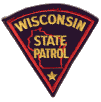
Wisconsin State Patrol
On September 1, 1939, the Wisconsin legislature passed a statute creating the Motor Vehicle Department, which consisted of three divisions - the new enforcement division began with 46 “inspectors” to enforce the state motor vehicle code and the regulating of motor carriers. This was the nucleus of the Wisconsin State Patrol.
The "State Traffic Patrol" as it was known, saw their new officers in 1939, purchase their own patrol cars, and received a $30 per month reimbursement from the state, plus fuel, oil and grease. Each STP Officer received a siren, a flashing red light, and special license plates to display while on duty.
When the patrol car had to be used for personal reasons, the special plates had to come off and be replaced with regular personal plates. Despite this tiresome practice, the departmental shield on the doors of the car remained in place whether on or off duty.
During the 1950's, the Patrol underwent major changes. The Patrol jumped from a force of 70 uniformed officers to 250. The patrol became authorized to use radar for traffic speed enforcement in 1953. Formal education instructions were started in 1955 with the establishment of a training academy at Fort McCoy. This was also the year that STP officers commenced firearms training.
The Patrol used gray patrol cars with a black roof and trunk, and 10% of patrol cars were unmarked. In the mid-1960's, the WSP went to a blue and white paint scheme which remained in place until the 1980's when cost considerations moved the WSP to choose an all blue car.
In 1956, the WSP acquired Harley Davidson motorcycles for the fleet. The division currently operates 14 safety and weight stations and the Wisconsin State Patrol academy which provides diverse law enforcement training programs for federal, state and local law enforcement officers.
The State Patrol promotes highway safety and enhances the quality of life for all Wisconsin citizens and visitors by providing professional, competent and compassionate law enforcement services. Some of the services they provide are: size/weight inspection, motor carrier safety assistance, ambulance inspection, school bus inspection, crash reconstruction, and mobile data communication.
Other services include aid to local law enforcement agencies through civil disturbance countermeasures, natural disaster recovery support, communications services and chemical testing services for drivers suspected of being under the influence of alcohol or other drugs.
Through the years many changes have been made, but the patrol’s goal has always been and will continue to be assisting the motoring public and making Wisconsin’s highways safe. The size of the patrol has increased to the present day strength of 400 troopers and 112 inspectors.
It is believed that from 1939 to 1941, patrol vehicles used by Wisconsin State Traffic Officers (purchased by the officer himself until 1951!) were issued ordinary passenger license plates with no specific number alotment. The earliest known titled Wisconsin State Traffic Patrol plates commenced around 1941 and used a similar format until 1955 although earlier versions varied. The early plates were painted black over yellow-orange and were made of embossed steel measuring 13 3/8" X 6". From the left of the plate there was a five point star over WIS followed by STATE over TRAFFIC over PATROL followed by the assignment number up to 2 digits. The eariest of this type used the smaller and more angular number dies where the background color utilized a more orange shade and the later types used the larger and more rounded number dies where the background color was more of a yellow.
These plates also featured a total of eight mounting holes (4 on top and 4 on the bottom).
They were run on the marked WSTP fleet until the end of 1955.
 1941-1955 issue. Embossed steel.
1941-1955 issue. Embossed steel.
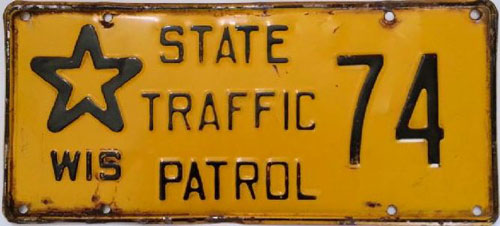 1941-1955 issue. Embossed steel.
1941-1955 issue. Embossed steel.
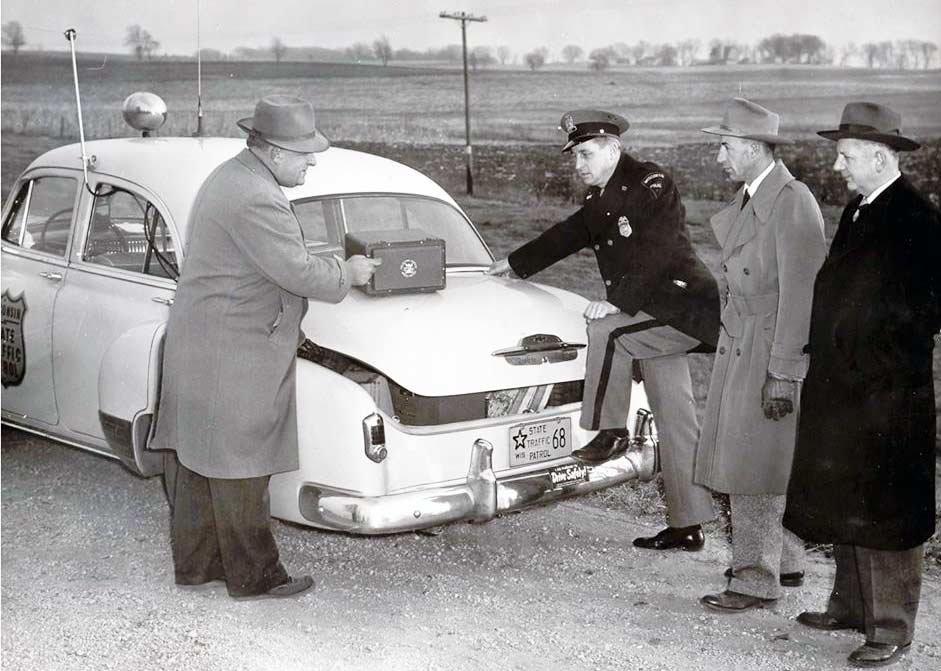 1952- Courtesy James Westover
1952- Courtesy James Westover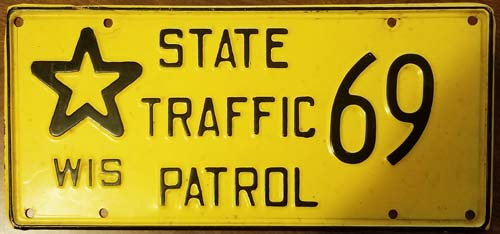 1941-1955 issue. Embossed steel.
1941-1955 issue. Embossed steel.
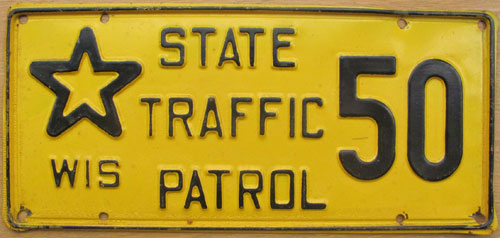 1941-1955 issue. Embossed steel.
1941-1955 issue. Embossed steel.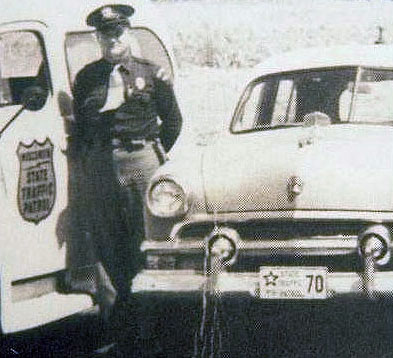
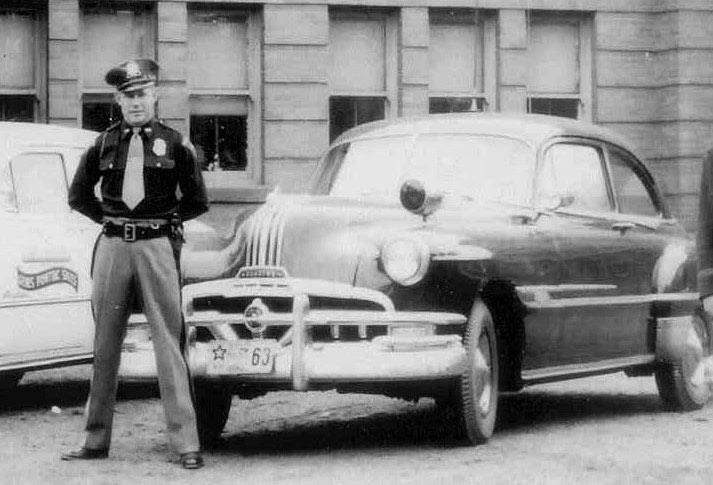 1952 Pontiac with Ptlm. Bruce Bishop
1952 Pontiac with Ptlm. Bruce Bishop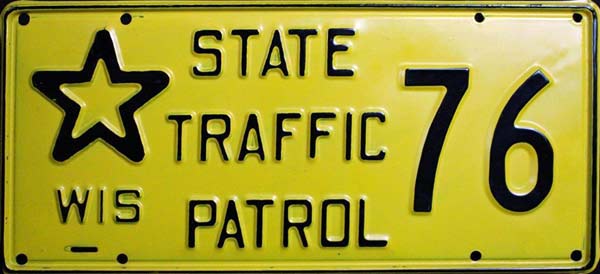 1941-1955 issue. Embossed steel.
1941-1955 issue. Embossed steel.
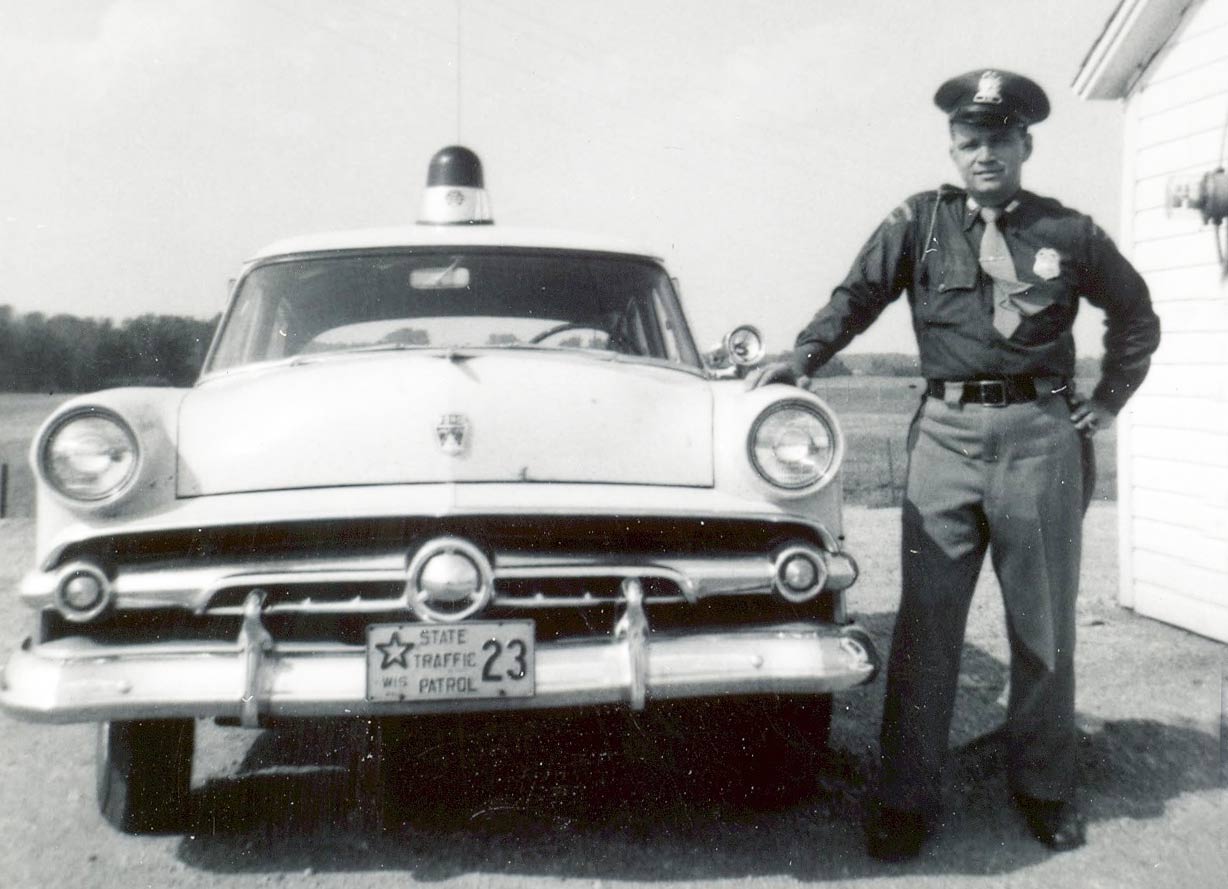 1954 Ford.
1954 Ford.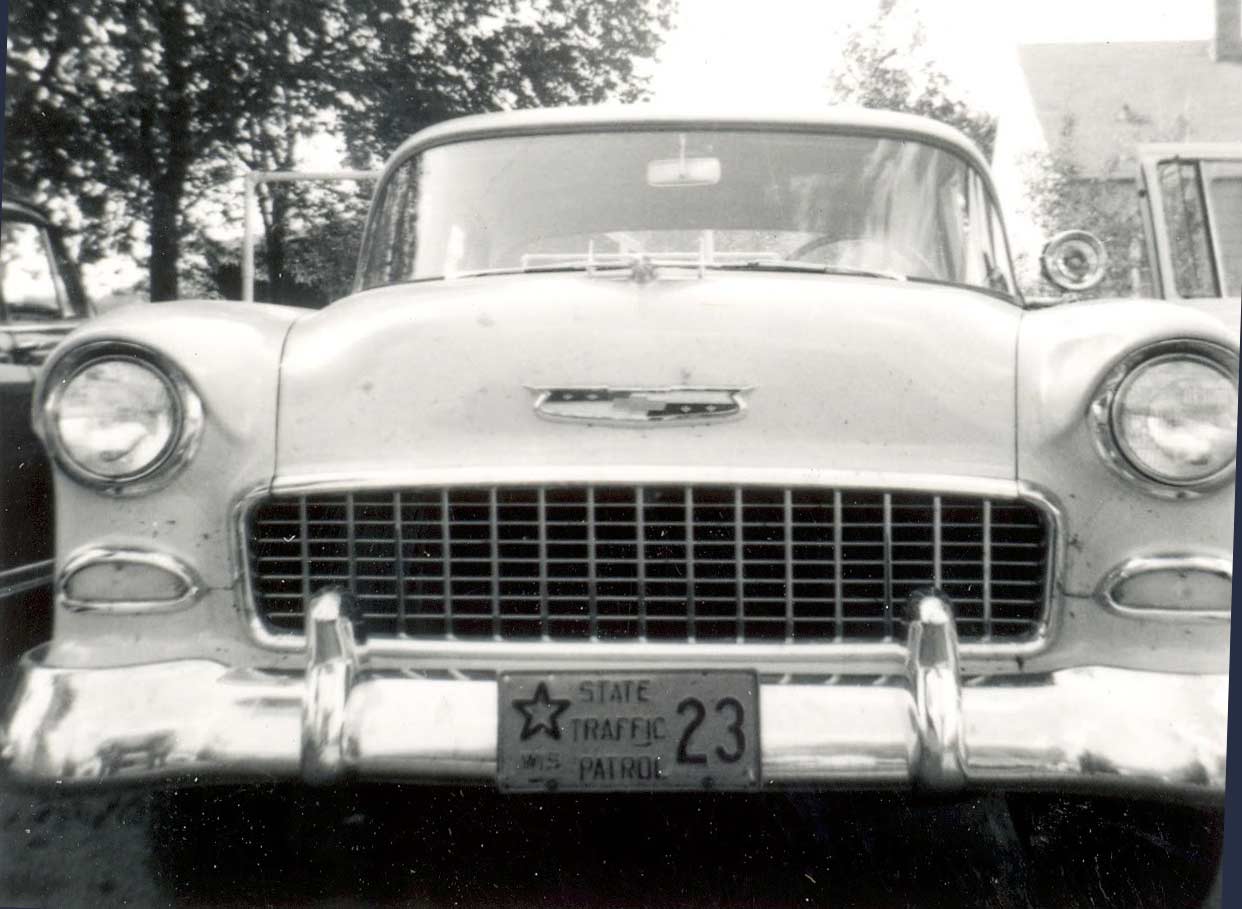 1955 Chevrolet with same license plate number as seen above.
1955 Chevrolet with same license plate number as seen above.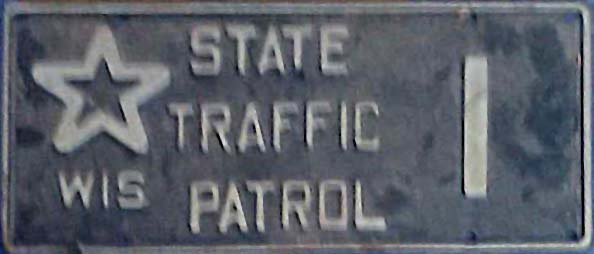 UNKNOWN COLOR SCHEME
UNKNOWN COLOR SCHEME
In 1956, when North America went to a standard size of 6" x 12" for all passenger car license plates, the Wisconsin State Patrol issued an embossed thin aluminum license plate of these dimensions but painted black over white. The layout of the plate set the design standard for all subsequent WSP license plates for the next 30+ years. The state name was always embossed at the bottom center of the plate, and the words STATE over PATROL always occupied the center left field of the plate. A five-point star motif preceded the assignment number. It has been stated by retired WSP officer Terry Stewart, that in 1957/1958, officers were assigned radio call numbers/license numbers based on their WSP badge numbers.
1959 saw the new radio call sign and license numbering scheme.
The District numbers were as follows:
1##: Madison
2##: Waukesha
3##: Fond du Lac
4##: Wausau
5##: Spooner
6##: Eau Claire
Numbers from 99 down were for headquarters and special units not assigned to a particular district. By May 6 1959, these three digit assignment numbers also became the radio call number for the vehicle. The numbers after the District number indicated the hierarchy for each location with the District Commander assigned 01, the Deputy District Commander assigned 02 etc... It was also at this time that WSP Communications Officers ran Wisconsin Municipal Government plates on their assigned cars and utilized assignment numbers 9, 10, 100, 300, 400 and 600. From 1956 until the WSP's 50th Anniversary in 1989, there were only eight variations to the black-and-white plates which will be itemized below.
The 1956 issue featured a long mounting slot in top left corner with 3 mounting holes in the other corners of the plate. The plate also had validation tab slots with squared edges in the top far-right corner, but WSP plates were deemed tax exempt, therefore annual validation tabs were not necessary or utilized. The plate featured a full length crease over the state name. A "broken" crease was applied below top mounting holes. It was believed that these indented creases gave the thin aluminum some structural rigidity. This issue ran until late 1959.
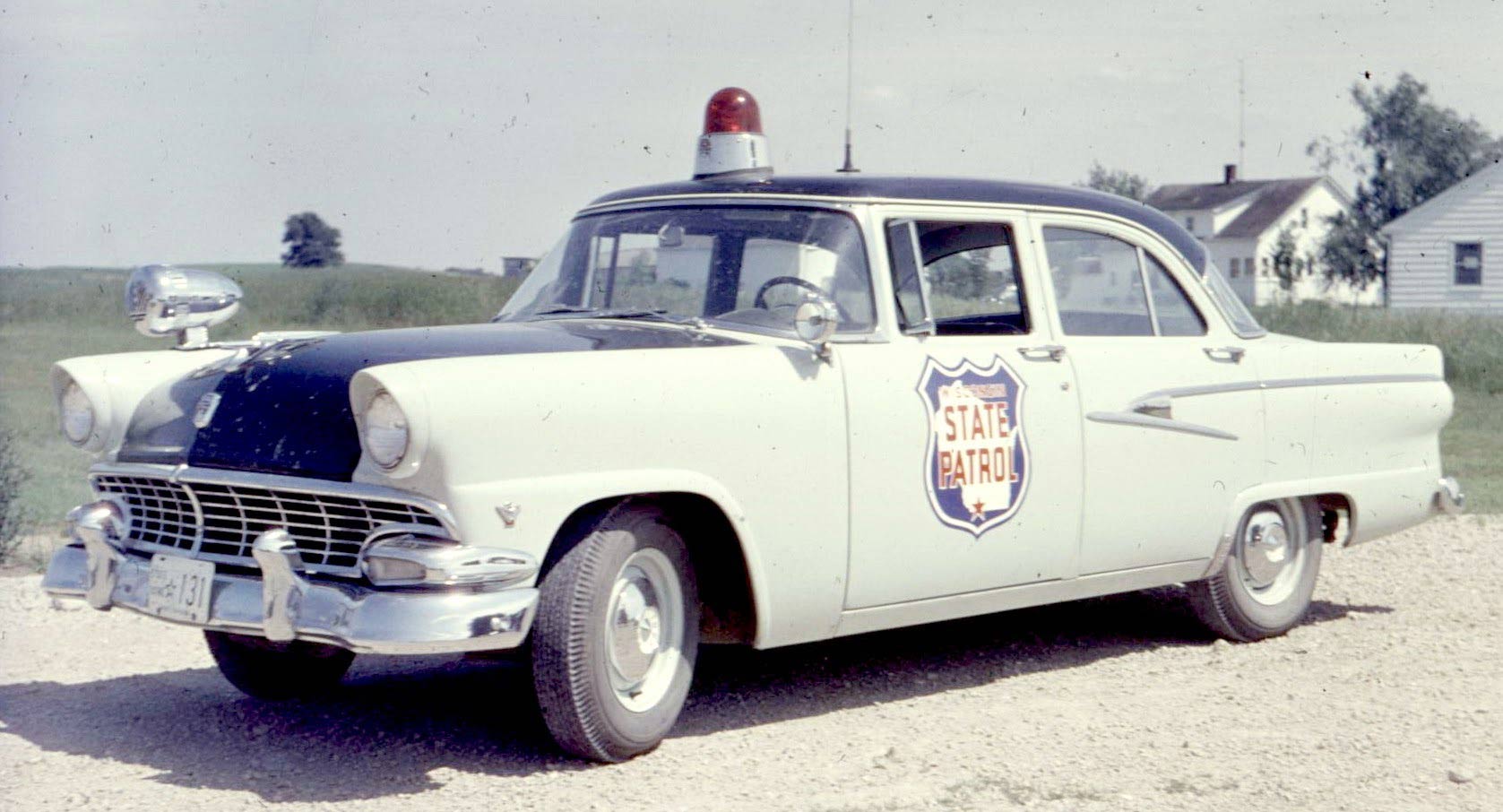
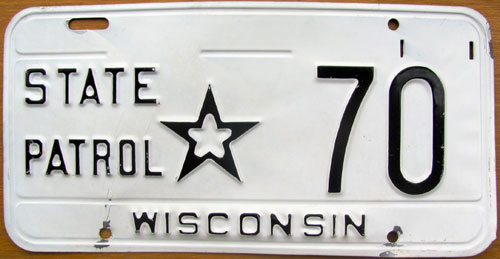 1956-1959 issue. Embossed aluminum. Black over white.
1956-1959 issue. Embossed aluminum. Black over white.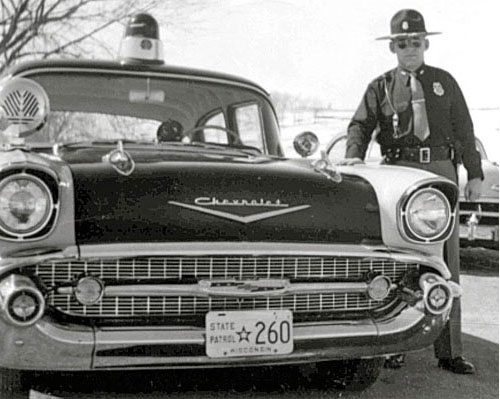 Art Shrock of the Brooklyn area-1957- Badge # 260
Art Shrock of the Brooklyn area-1957- Badge # 260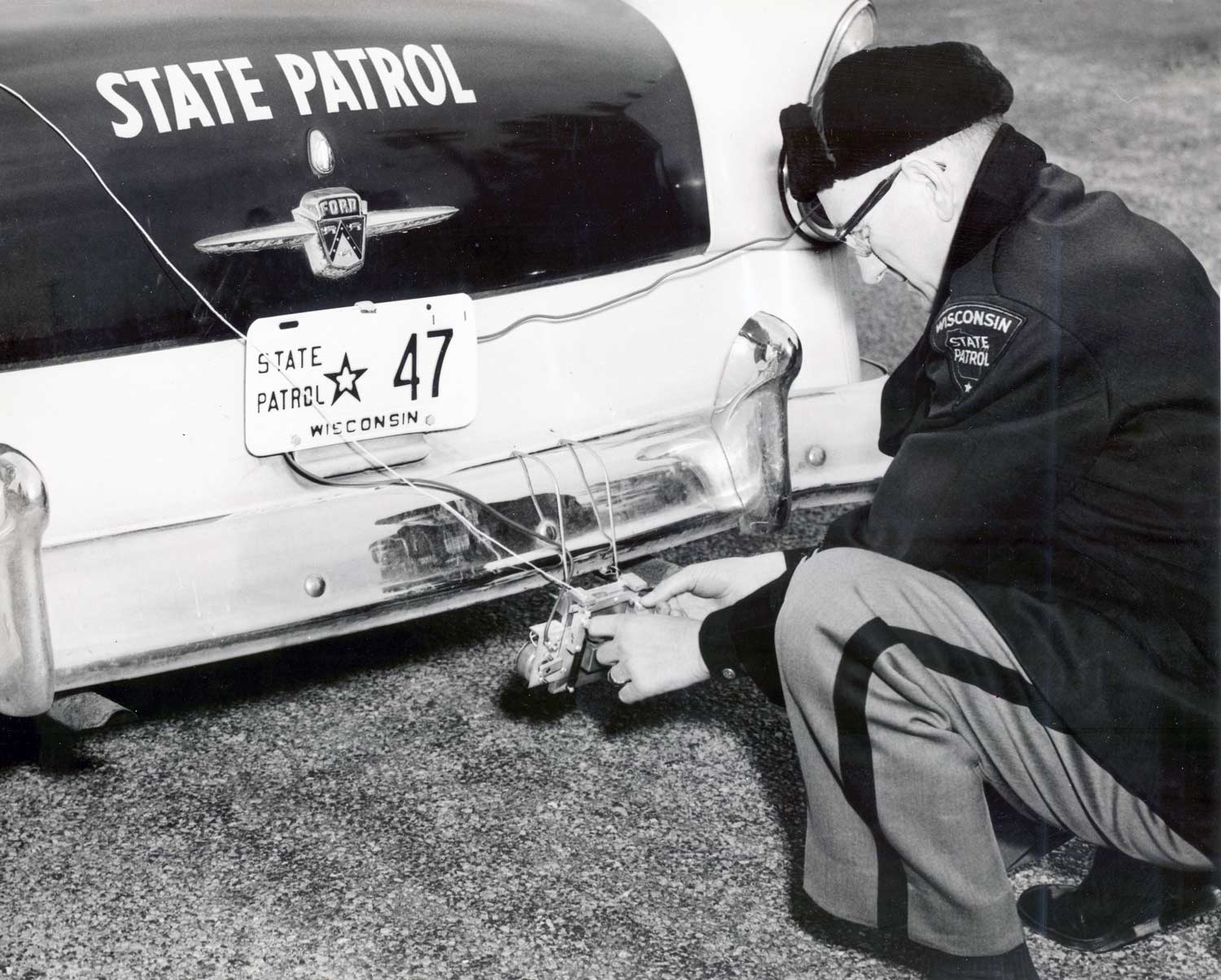 1956-1959 Headquarters issue.
1956-1959 Headquarters issue.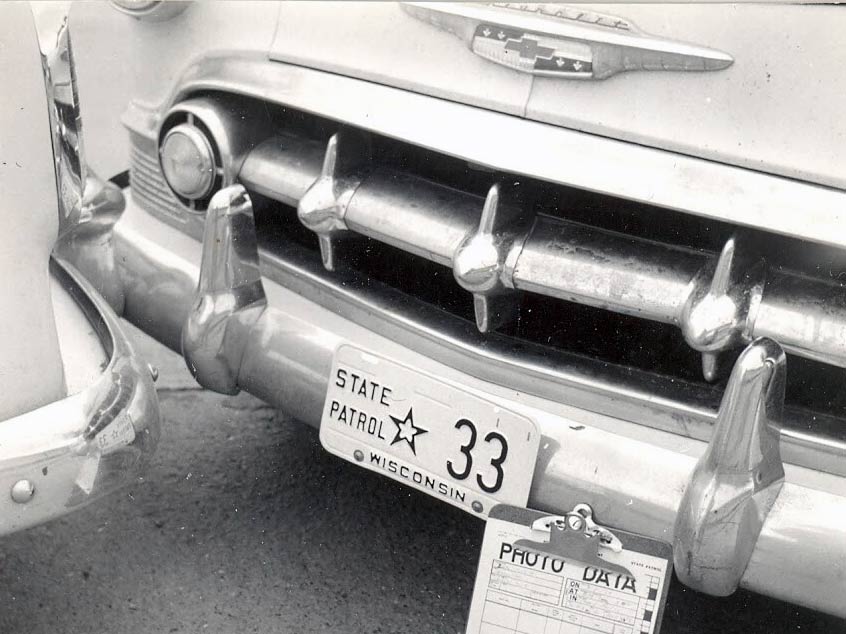 1956-1959 Headquarters issue.
1956-1959 Headquarters issue. Truck Inspection 1957.
Truck Inspection 1957.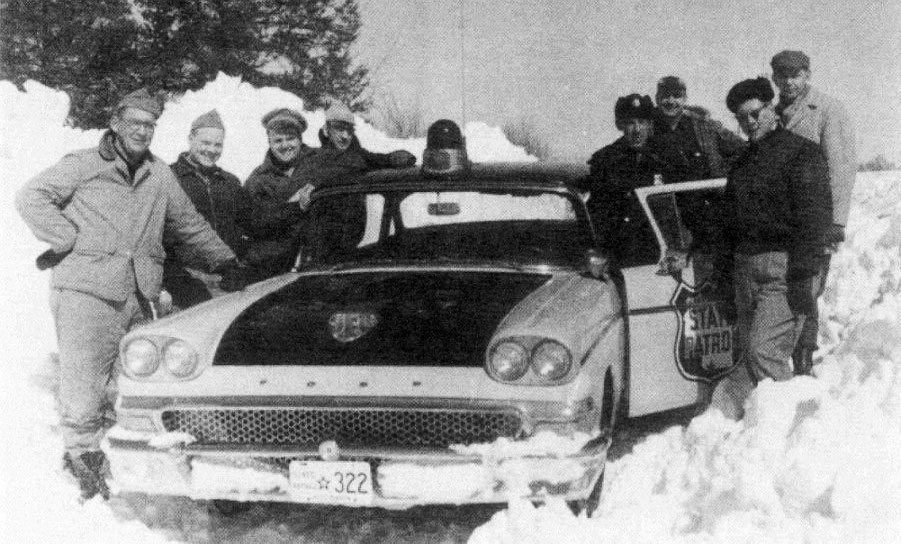
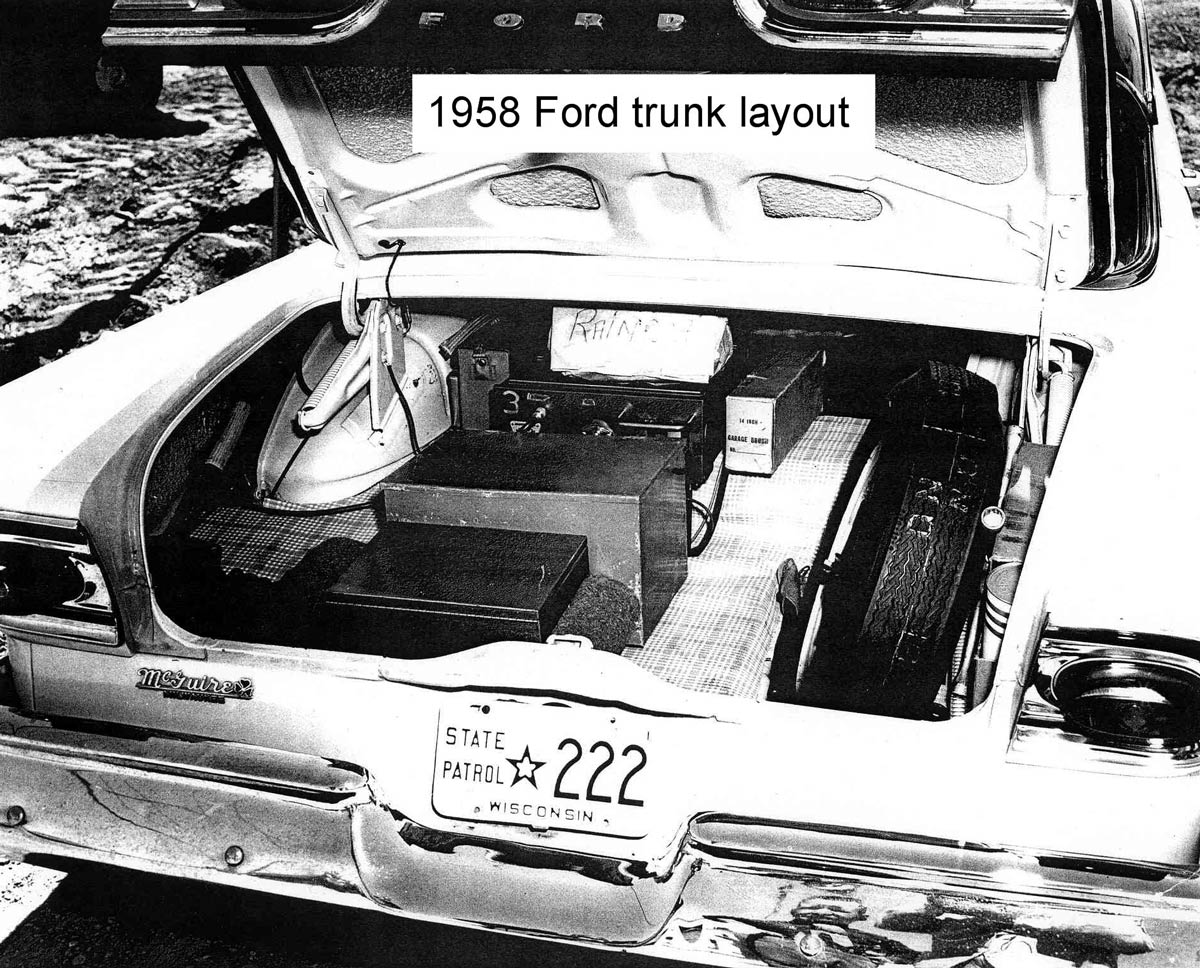 1958- Trunk contents for Badge # 222
1958- Trunk contents for Badge # 222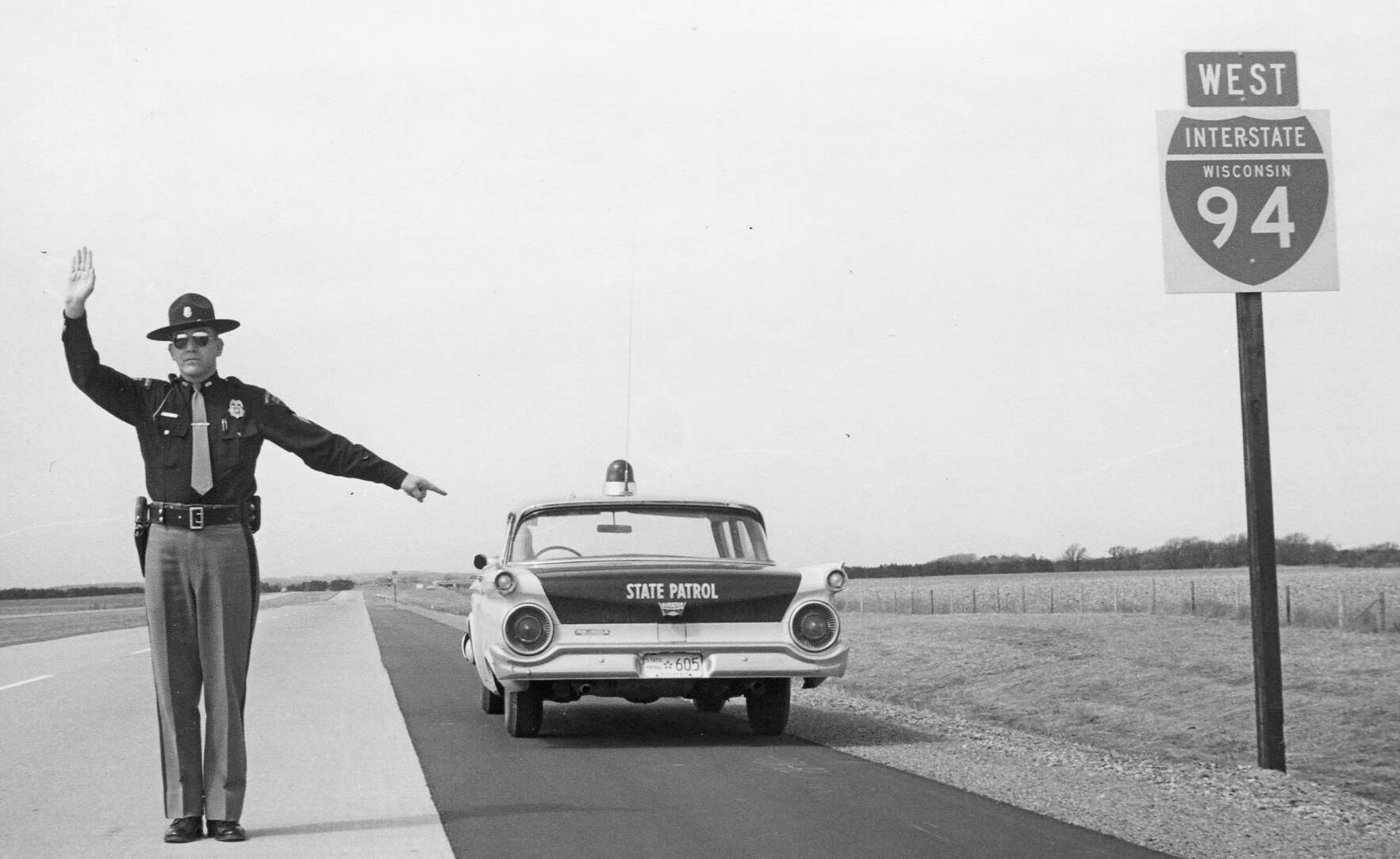
The next issue was for 1960-1961. This issue was not part of a fleet-wide change-over, but rather a current issue for newly-assigned cars during that time. It was also made of thin embossed aluminum. It was distinguished by a long mounting slot in lower left corner with 3 mounting holes in the other corners. The tab slots on this issue had rounded edges as opposed to the squared ones on the previous issue. There was once again a full length crease over the state name, but it had no top crease.
As mentioned earlier, 1959 saw the switch to District/Radio Call numbers from badge numbers on WSP license plates.
It was on this base plate where the numbering alotment was as follows:
(The District number is represented as an X):
X00: District Radio Techs
X01: District Commander (Captain)
X02: District Deputy Commander (Lieutenant)
X03-X09- District Sergeants
X11-X89- Patrolmen
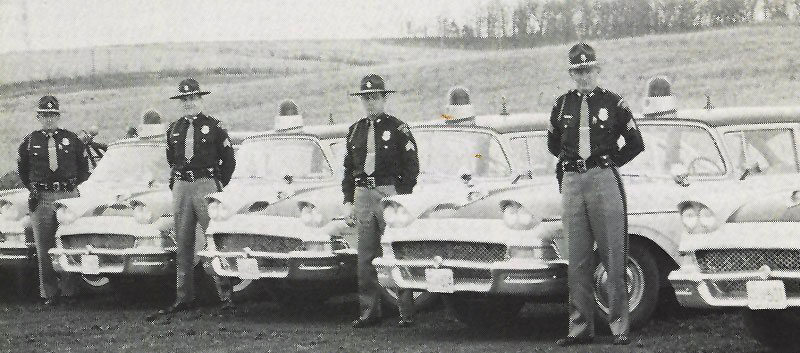
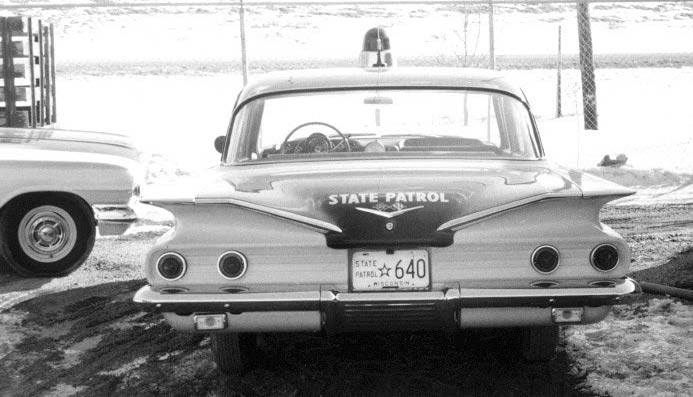
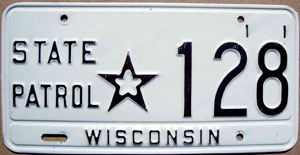 1960-1961 issue. Embossed aluminum.
1960-1961 issue. Embossed aluminum.
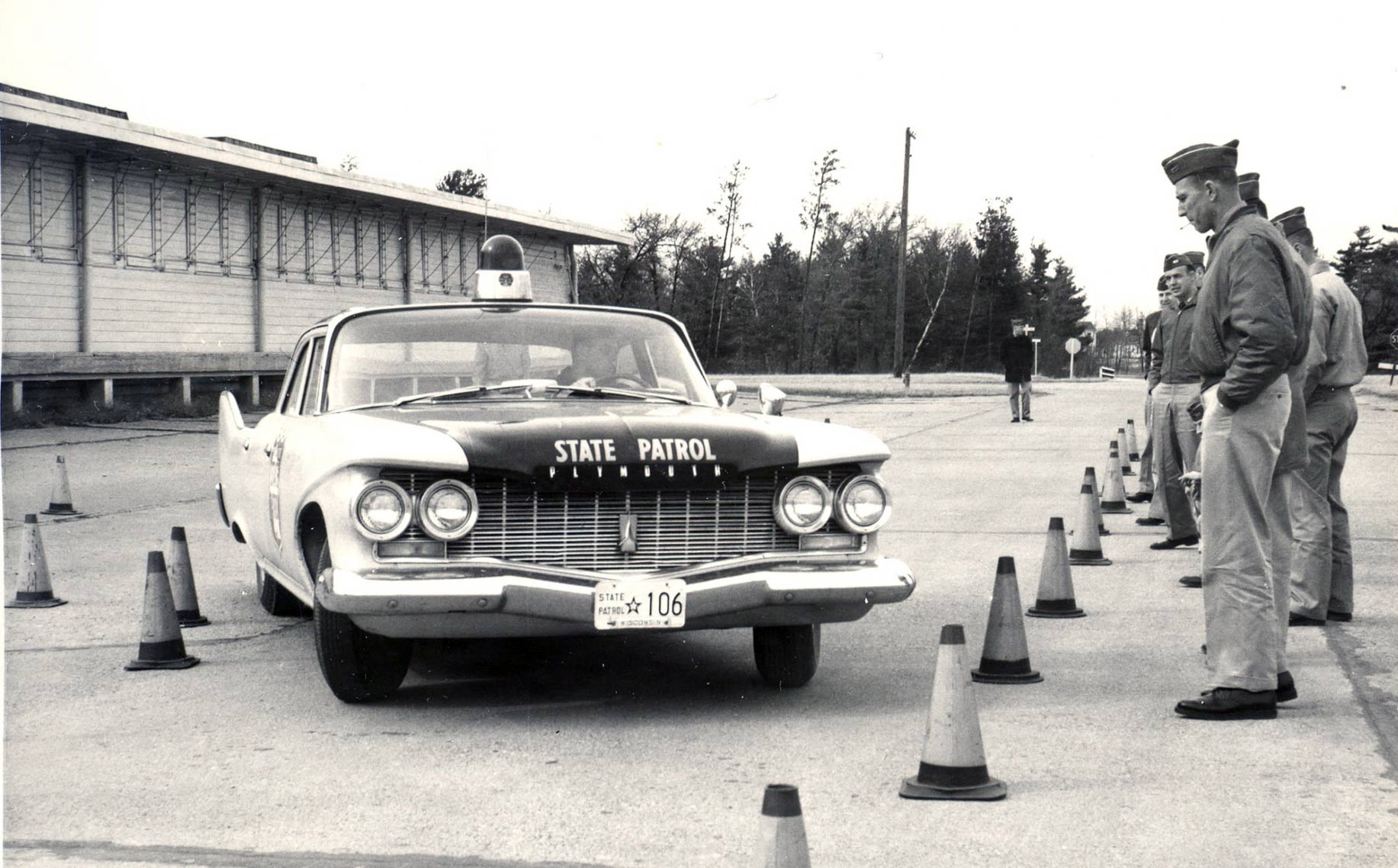 District 1 (Madison) 1960.
District 1 (Madison) 1960.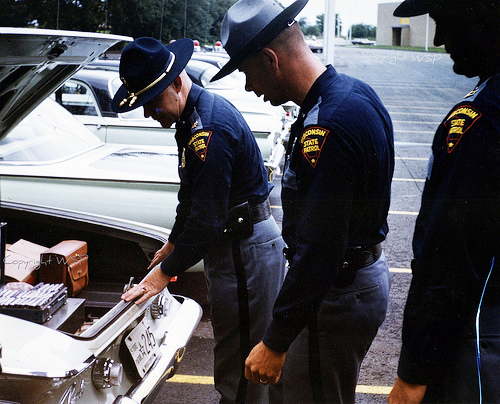 Patrol Vehicle Inspection-District 2 (1961)
Patrol Vehicle Inspection-District 2 (1961)The next design change was for 1962-1964. This issue was also not part of a fleet-wide change-over, but rather a current issue for newly-assigned cars during that time. It was also made of thin embossed aluminum. The only difference between this issue and the previous issue was that the long mounting slot was now in the upper left corner of the plate with 3 mounting holes in the other corners. Otherwise, it was identical to the previous issue.
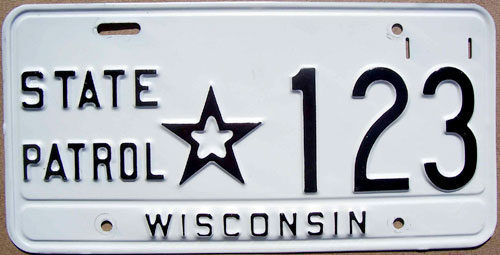 1962-1964 issue. Embossed aluminum.
1962-1964 issue. Embossed aluminum.
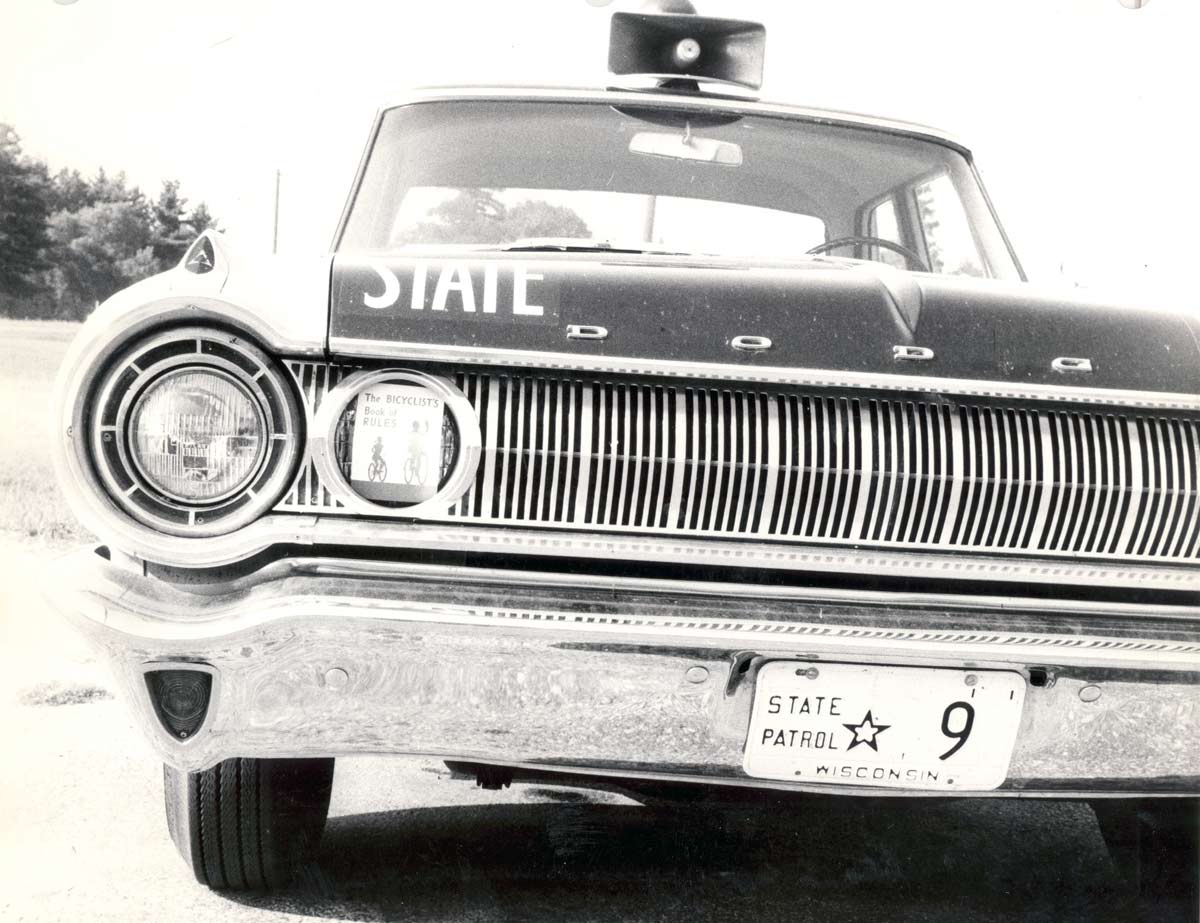 Headquarters issue for 1962-1964.
Headquarters issue for 1962-1964. 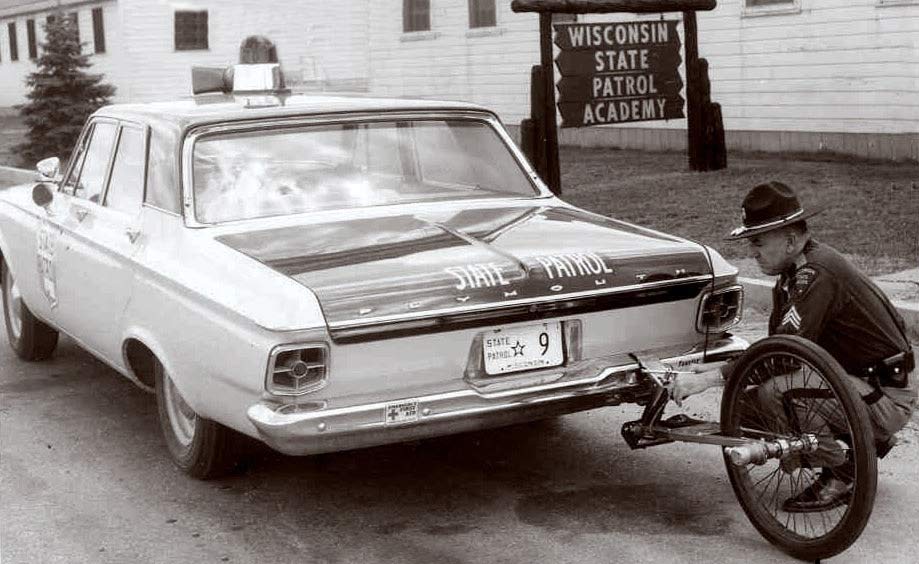 Trackmeter preparation. 1964
Trackmeter preparation. 1964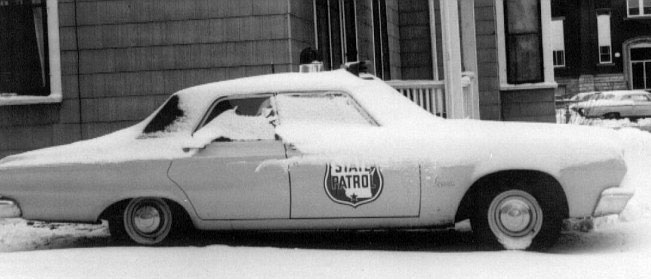
1965-1966 issue- This issue was also not part of a fleet-wide change-over, but rather a current issue for newly-assigned cars during that time. It was also made of embossed aluminum. It was also made of thin embossed aluminum. This issue was identical to the 1962-1964 issue but did not feature any validation tab slots.
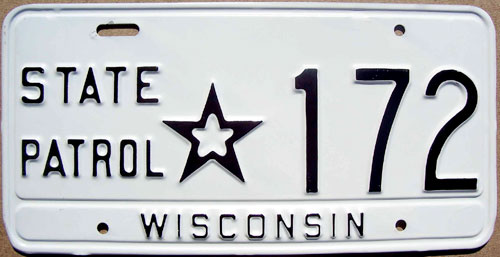 1965-1966 issue. Embossed aluminum.
1965-1966 issue. Embossed aluminum.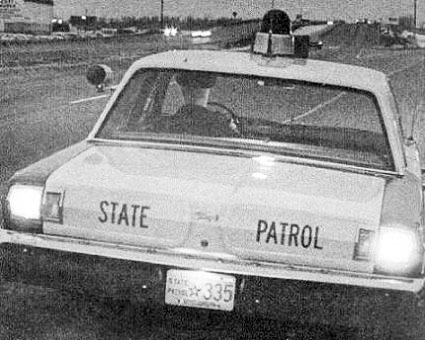
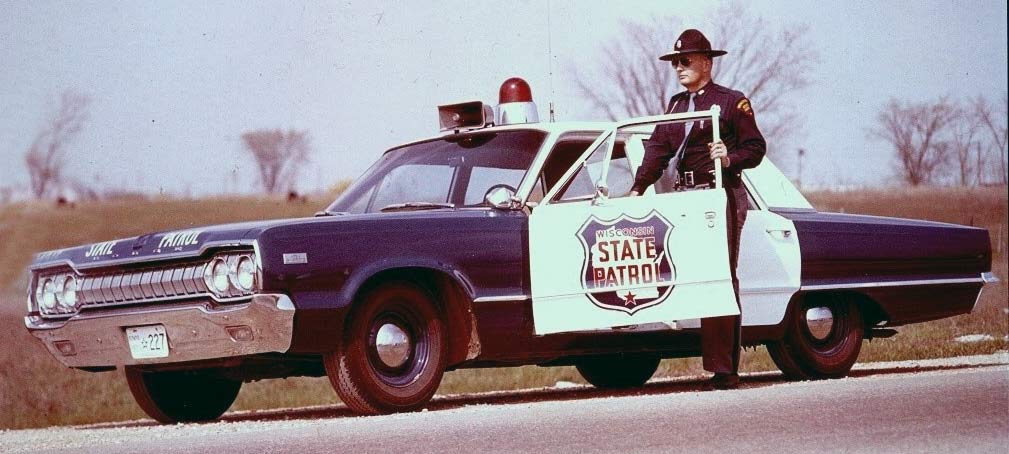 1965- Howard Goetch-District 2 (Waukesha)
1965- Howard Goetch-District 2 (Waukesha)1967-1972 issue- This issue was part of a fleet-wide change-over. The plate was made of a more durable embossed aluminum. A dull reflective white sheeting was used in lieu of the previous flat white painted background. This version was characterized by the "Keyhole" mounting slot in the lower right corner with 3 mounting holes in the other corners. This version featured a full length crease just below upper bolt-holes but with no bottom crease. WISCONSIN was embossed in larger dies. Plates on this series ending in 00 were assigned to the radio technicians for each district and trooper numbers began at 11 for each district. These plates although only issued until 1972 were still considered valid until 1987.
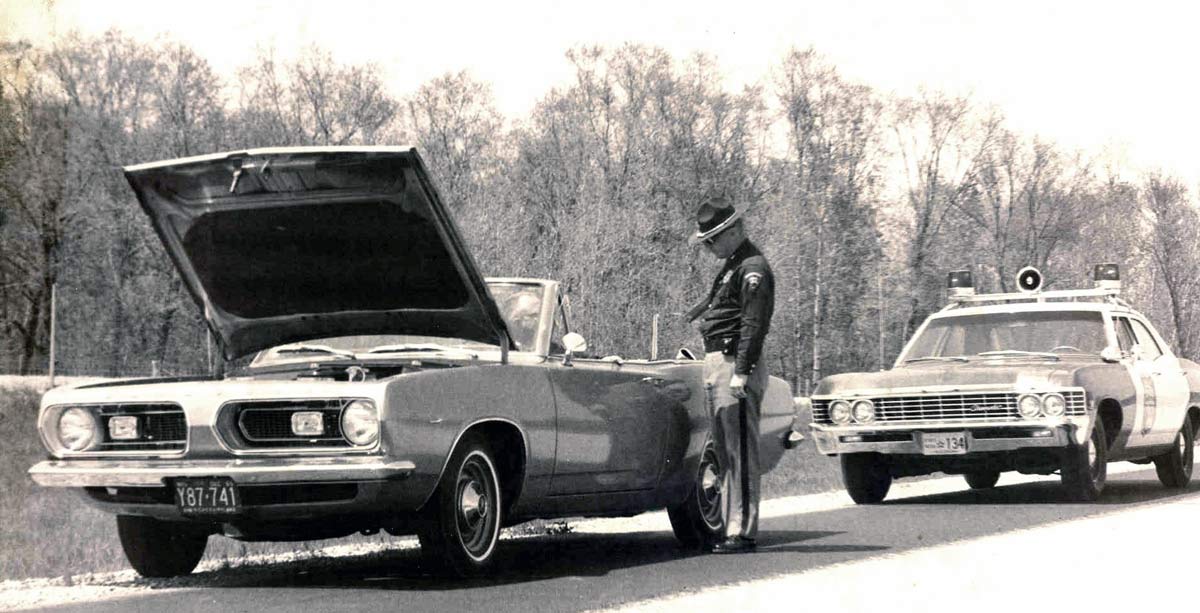 Motorist assist-District 1 (Madison) 1967
Motorist assist-District 1 (Madison) 1967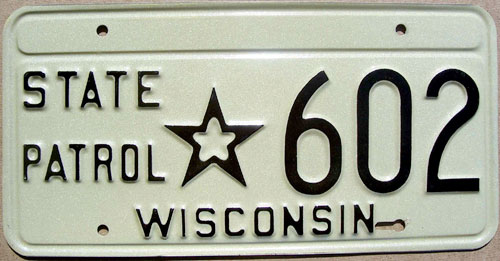 1967-1972 issue. Embossed aluminum.
1967-1972 issue. Embossed aluminum.
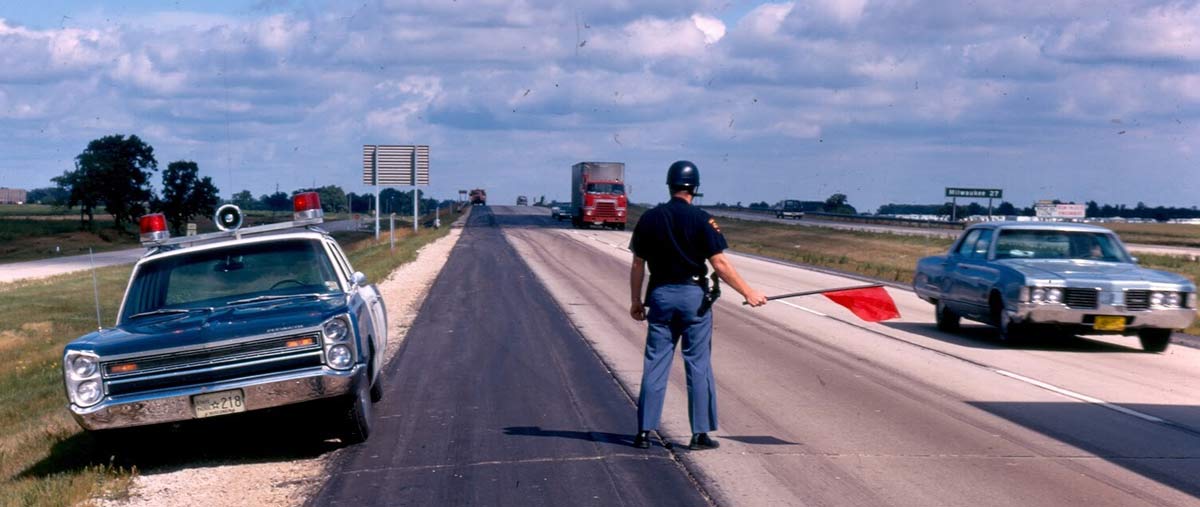 Daredevil traffic stop method- 1968
Daredevil traffic stop method- 1968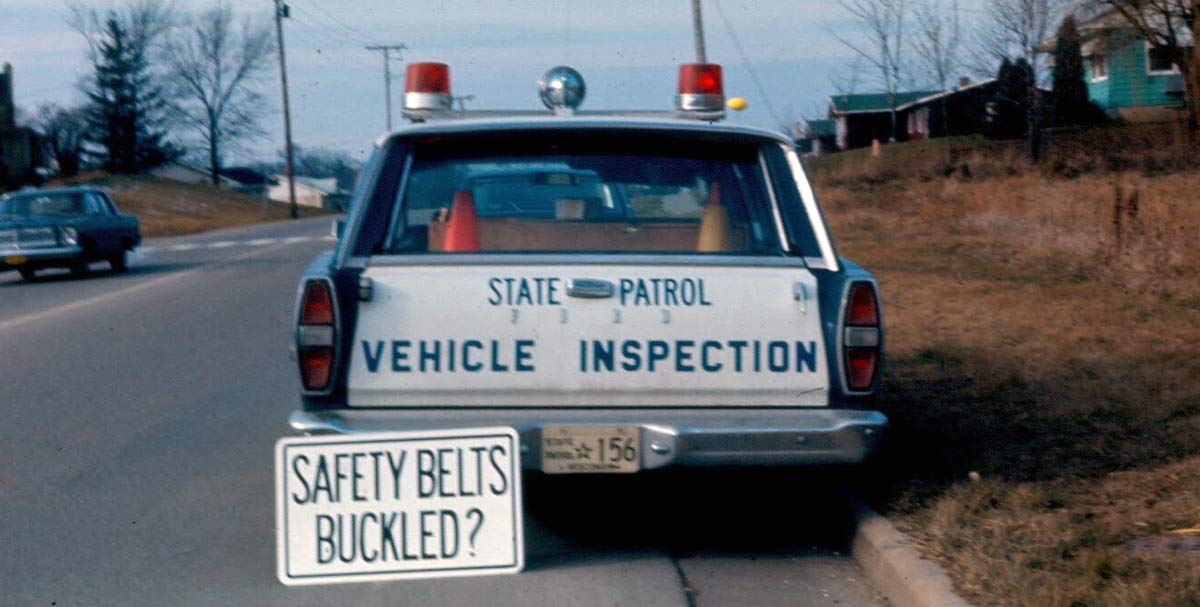 1969 Vehicle Inspection- Madison.
1969 Vehicle Inspection- Madison.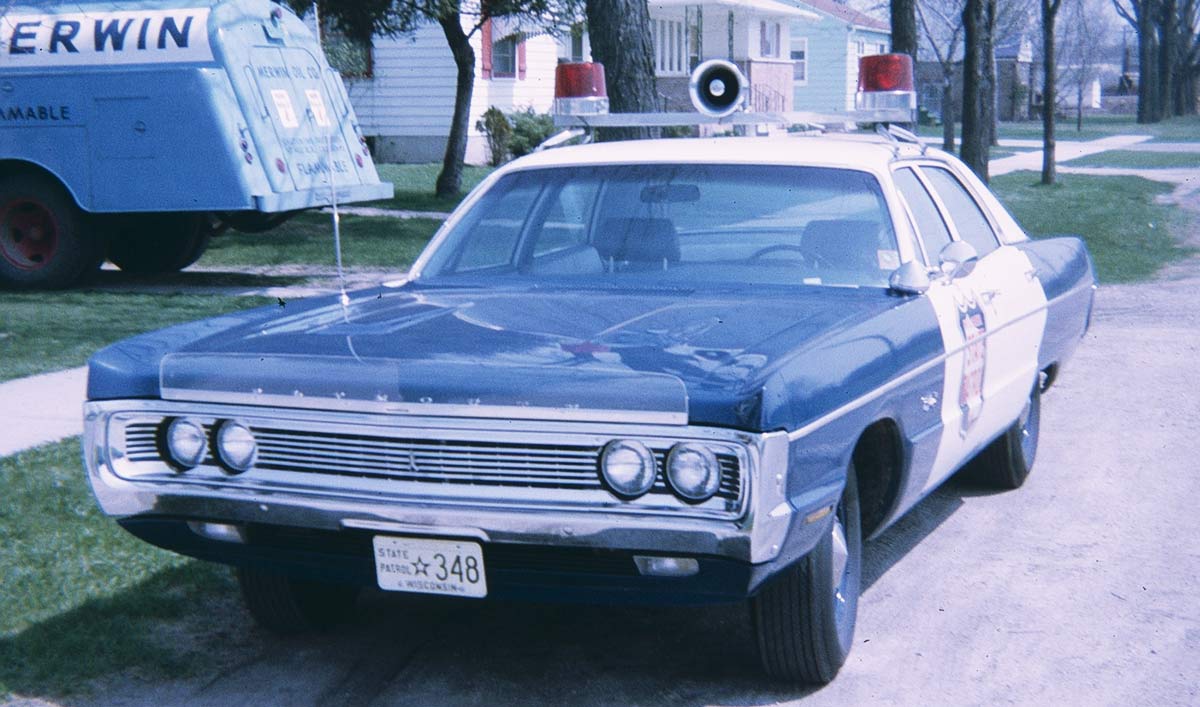 1971 District 3 (Fond du Lac)
1971 District 3 (Fond du Lac)1972-1977 issue- This embossed aluminum plate also utilized dull reflective white sheeting. This issue was not part of a fleet-wide change-over but rather a current issue for newly-assigned cars during that time. As with the 1967 issue, the "Keyhole" mounting slot was placed in the lower right corner with 3 mounting holes in the other corners. Partial crease that runs the span below the two upper bolt-holes. On this base, plate numbers 10, 11 and 12 were issued to the Patrol Academy and 13 was issued to the Director of the Academy. Plates issued in the 900 number bloc were for "Loans out of Madison" which were cars in-transit from HQ to a post or while being repaired.
In 1975, the WSP District Headquarters were as follows:
1##: Madison
2##: Waukesha
3##: Fond du Lac
4##: Wausau
5##: Tomah
6##: Eau Claire
8## Spooner
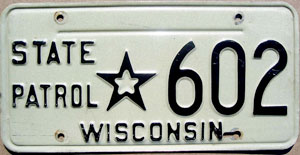 1972-1977 issue. Embossed aluminum.
1972-1977 issue. Embossed aluminum.
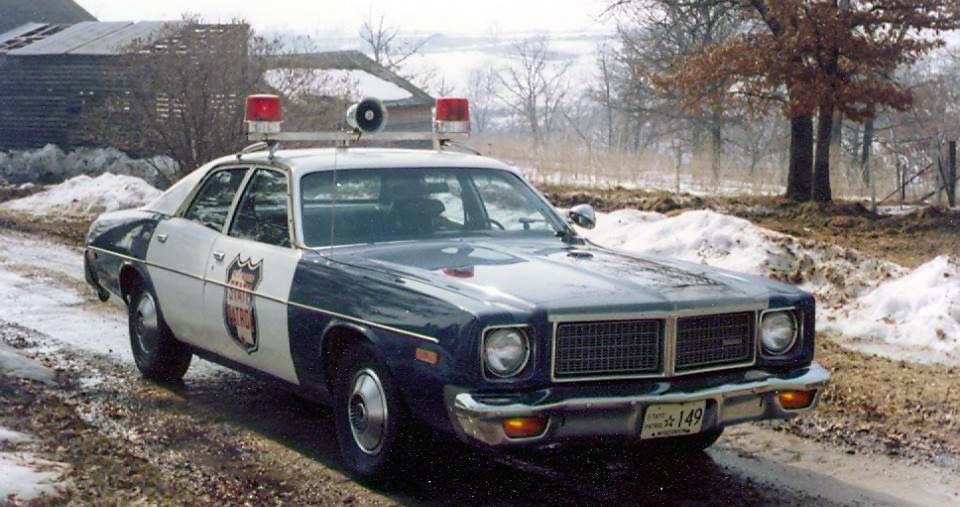 1976- District 1 (Madison) Courtesy Neal Sieglaff
1976- District 1 (Madison) Courtesy Neal Sieglaff1977-1987 issue- This embossed aluminum plate was similar to the 1972 issue with the only exception being the use of bright reflective sheeting, and a full length crease just below upper bolt-holes.
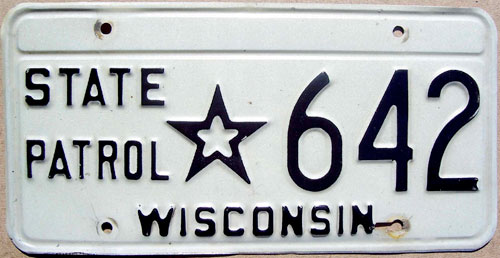 1977-1987 issue. Embossed aluminum.
1977-1987 issue. Embossed aluminum.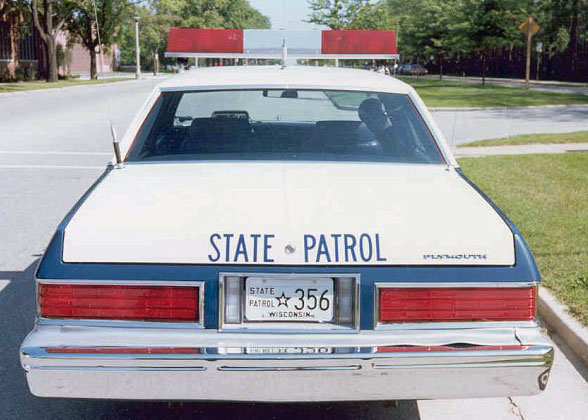 District 3 (Fond du Lac) 56
District 3 (Fond du Lac) 56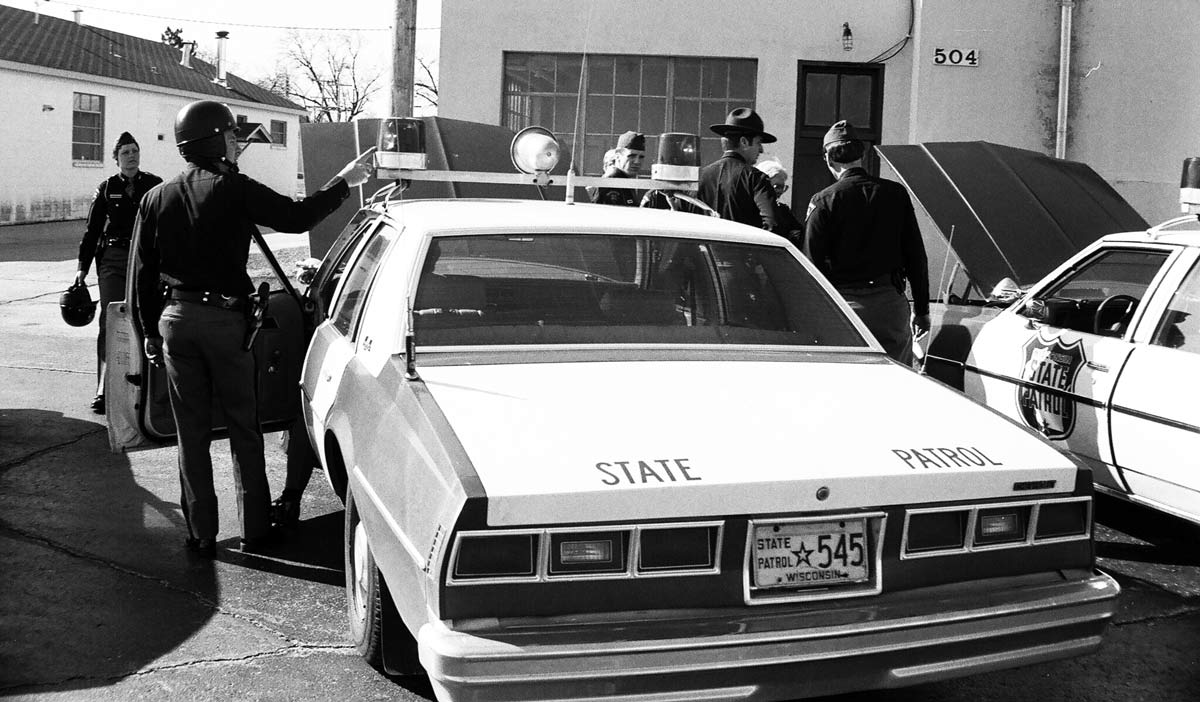 Late 1970's- District 5 (Tomah)
Late 1970's- District 5 (Tomah)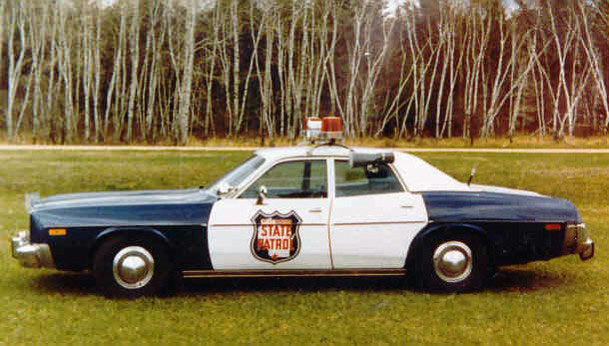
1987-1988 issue- This embossed aluminum plate was characterized by bright reflective sheeting. 4 round mounting holes and no creases.
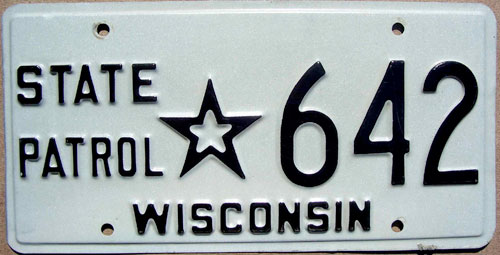 1977-1987 issue. Embossed aluminum.
1977-1987 issue. Embossed aluminum.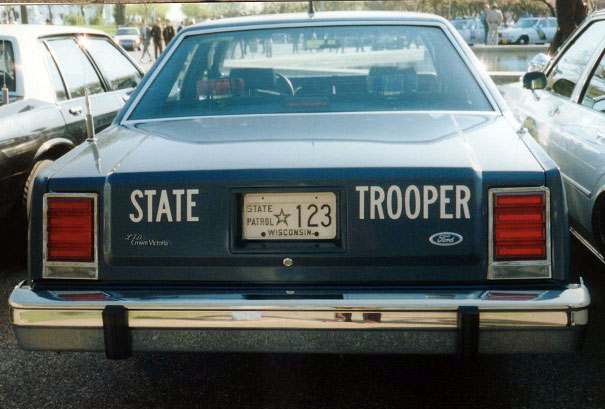 Madison # 23
Madison # 23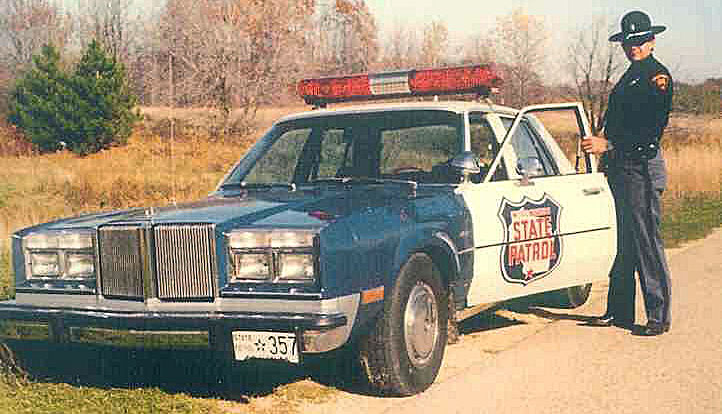
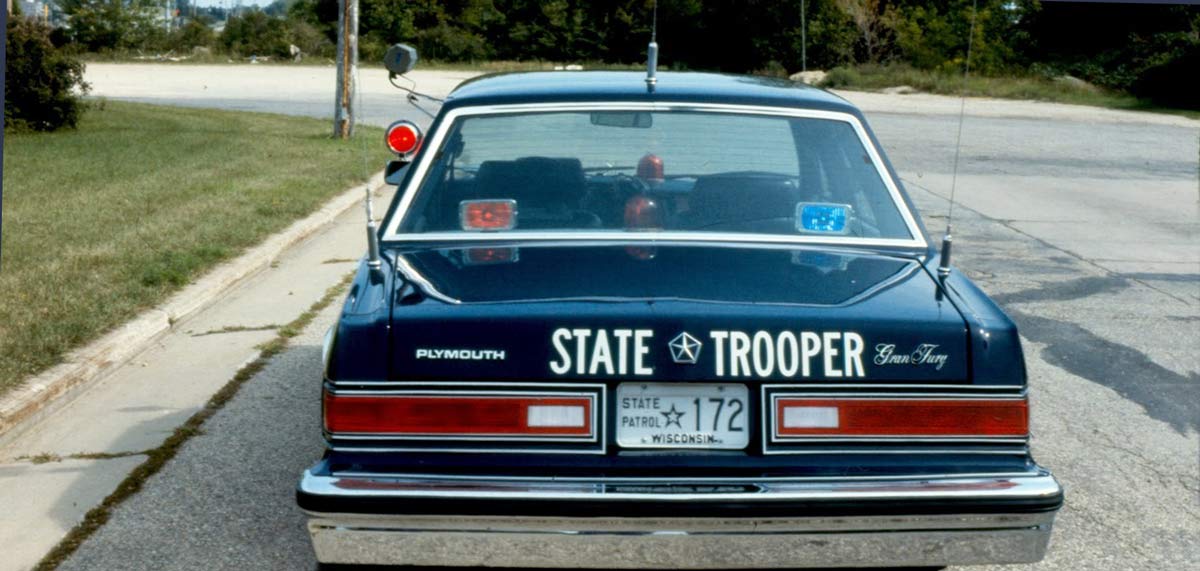 (Courtesy David A. Harvey- WSP/DOT Technical Services Section)
(Courtesy David A. Harvey- WSP/DOT Technical Services Section)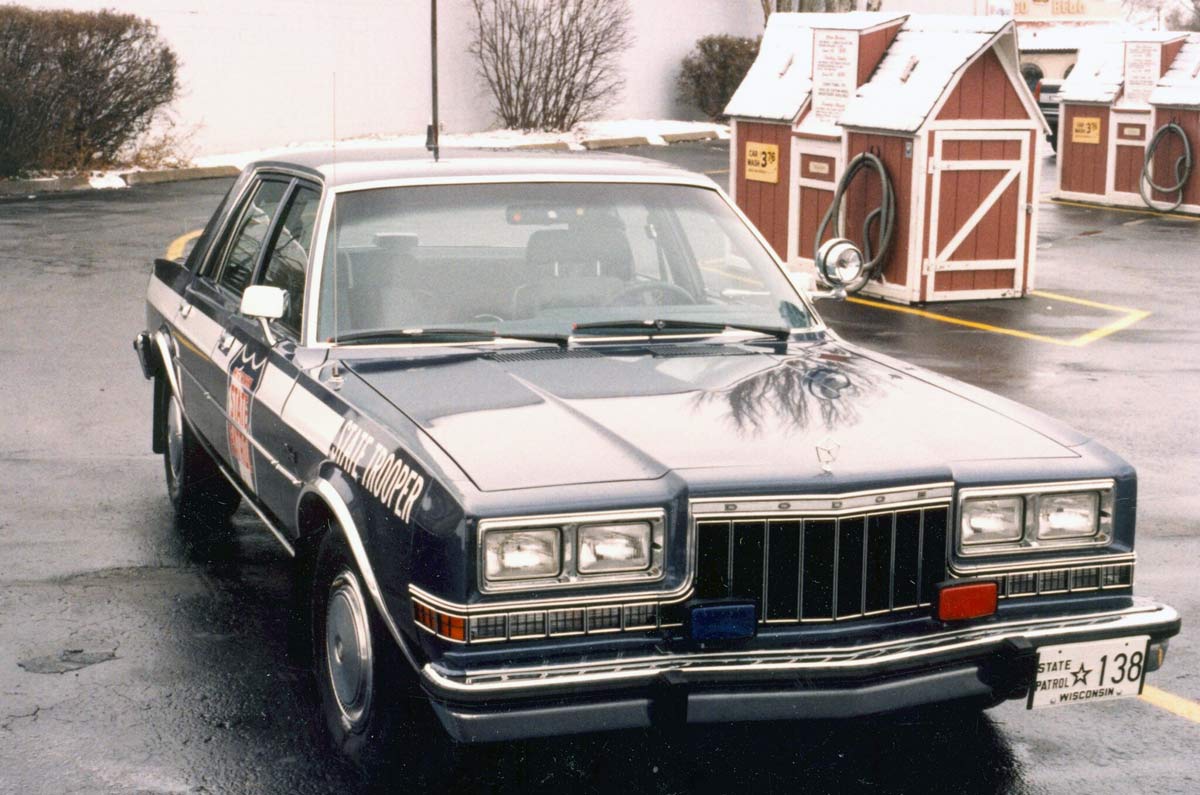 (Courtesy David A. Harvey- WSP/DOT Technical Services Section)
(Courtesy David A. Harvey- WSP/DOT Technical Services Section)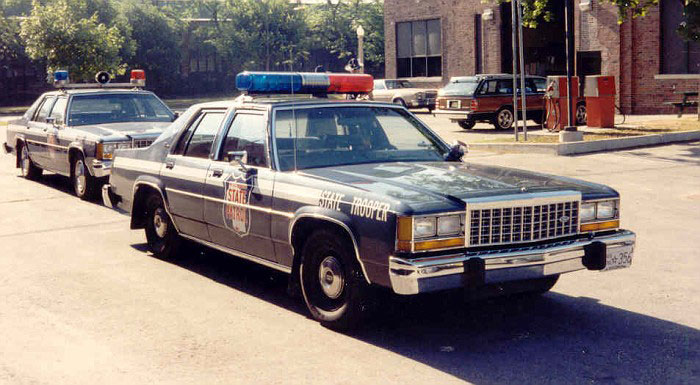
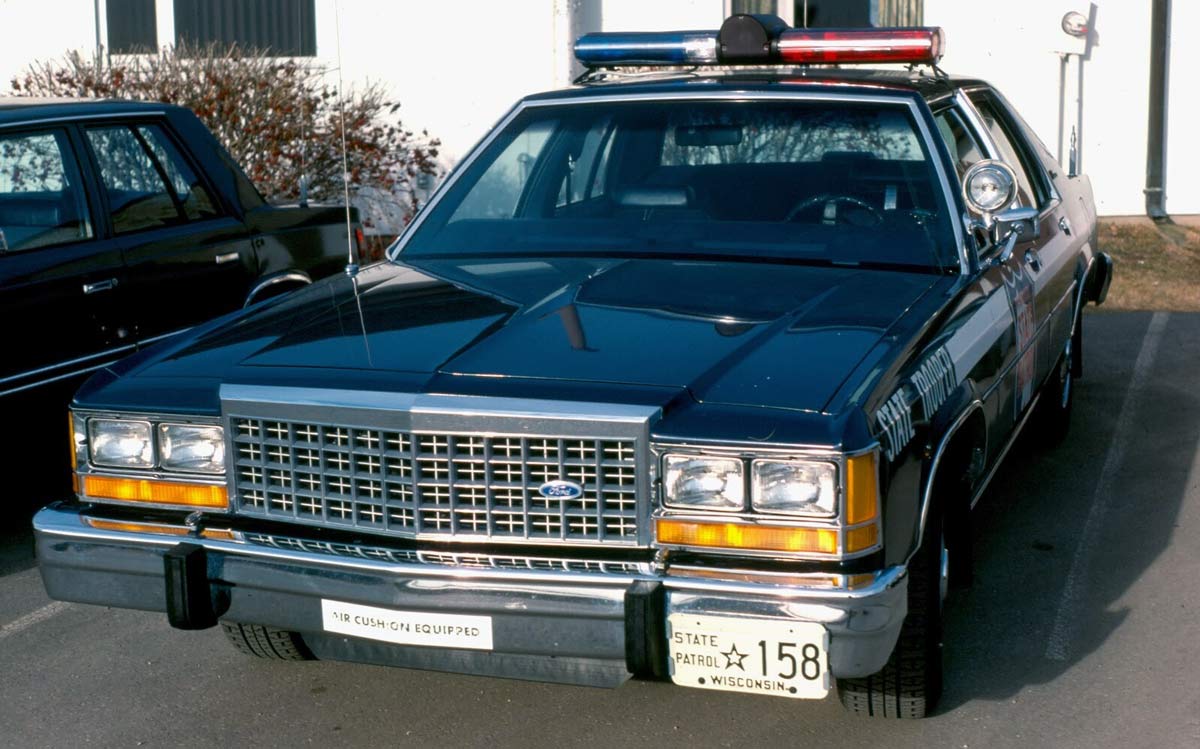 Madison (District 1) 1986.
Madison (District 1) 1986.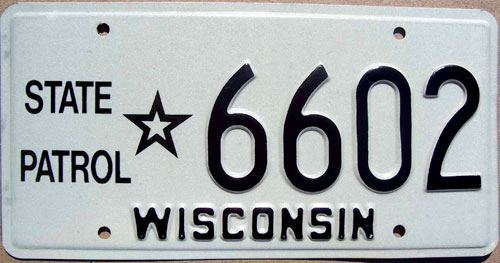 Mid 1988 issue- Embossed aluminum plate with bright reflective sheeting- STATE PATROL and the 5-point star were silkscreened instead of embossed. This issue was short-lived as the 50th Anniversary license plates were rolled-out during this time, and it was believed that the silkscreened section only applied to Motor Carrier Enforcement plates.
Mid 1988 issue- Embossed aluminum plate with bright reflective sheeting- STATE PATROL and the 5-point star were silkscreened instead of embossed. This issue was short-lived as the 50th Anniversary license plates were rolled-out during this time, and it was believed that the silkscreened section only applied to Motor Carrier Enforcement plates. 
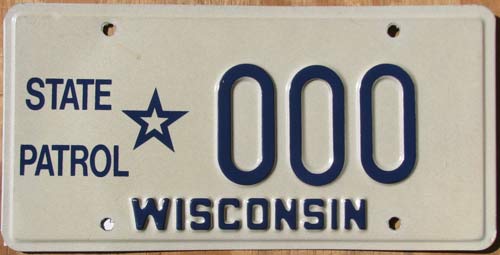 1988 prototype sample.
1988 prototype sample. 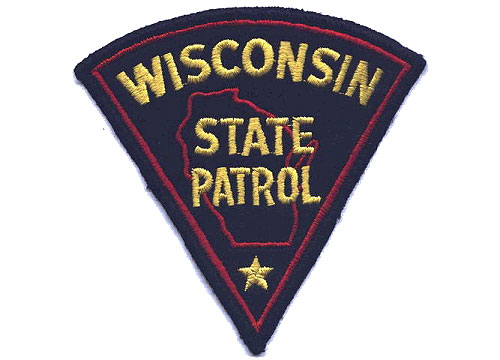
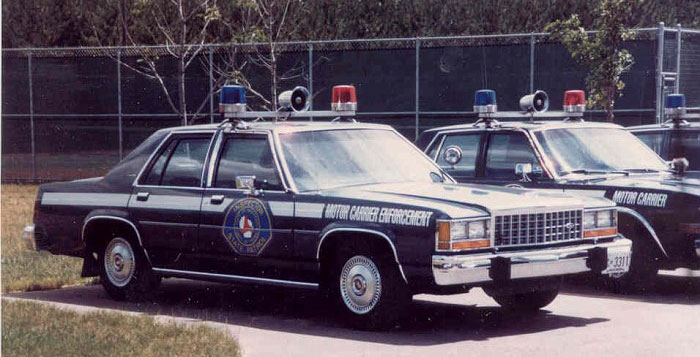
1989-2000 issue- This multi-colored and attractive embossed aluminum plate was created to commemorate the WSP's Golden Anniversary in 1989. This issue had embossed numerals in dark blue situated on a field of reflective "gold" that occupied the center horizontal span of the plate just below the upper and just above the lower mounting holes. The remainder of the plate was silkscreened in white. The emblem of the WSP was silkscreened in full color to the left of the first number. 1939 50 YEARS 1989 was silkscreend in blue in the top white banner and WISCONSIN was silkscreened in blue in the bottom white banner. This plate was used for over 10 years and began to be phased-out by 2000.
It was on this base plate where the numbering alotment was as follows:
The District number is represented as an X:
X00-XX00: District Radio Techs
X01- District Commander
X02- District Deputy Commander (Executive Officer)
X03-X10- District Sergeants
XX01-XX09- District Motor Carrier Enforcement Sergeants
XX10- District Motor Carrier Enforcement Inspectors
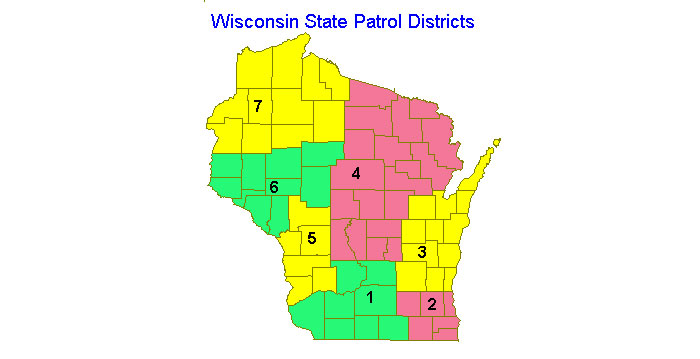
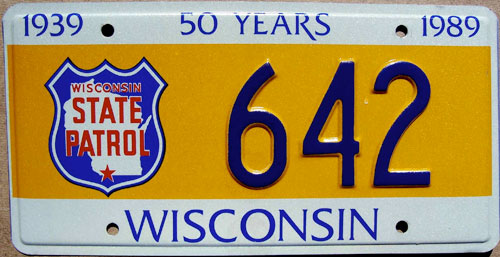 1989-2000 50th Anniversary issue.
1989-2000 50th Anniversary issue.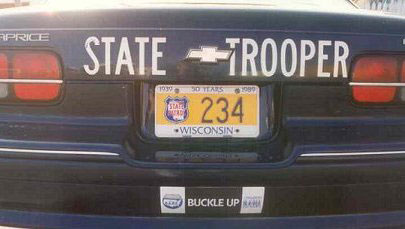 Waukesha- # 34
Waukesha- # 34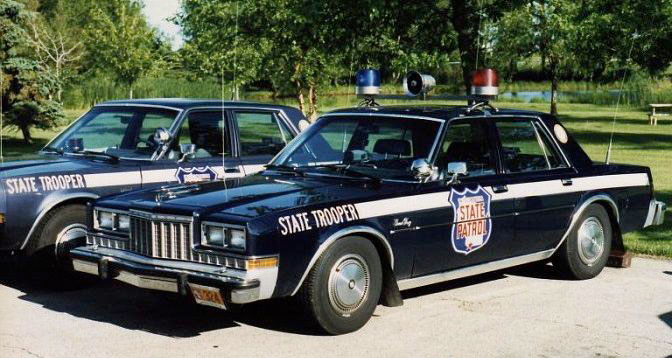
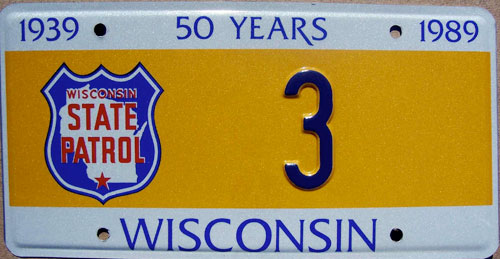 1989-2000 50th Anniversary issue.
1989-2000 50th Anniversary issue.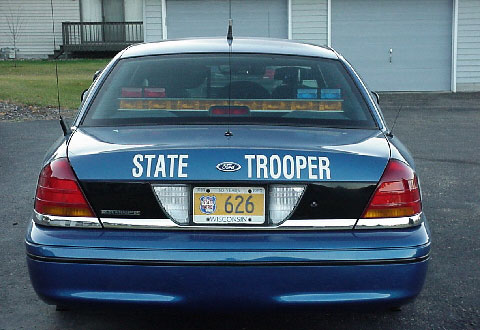 Eau Claire- # 26
Eau Claire- # 26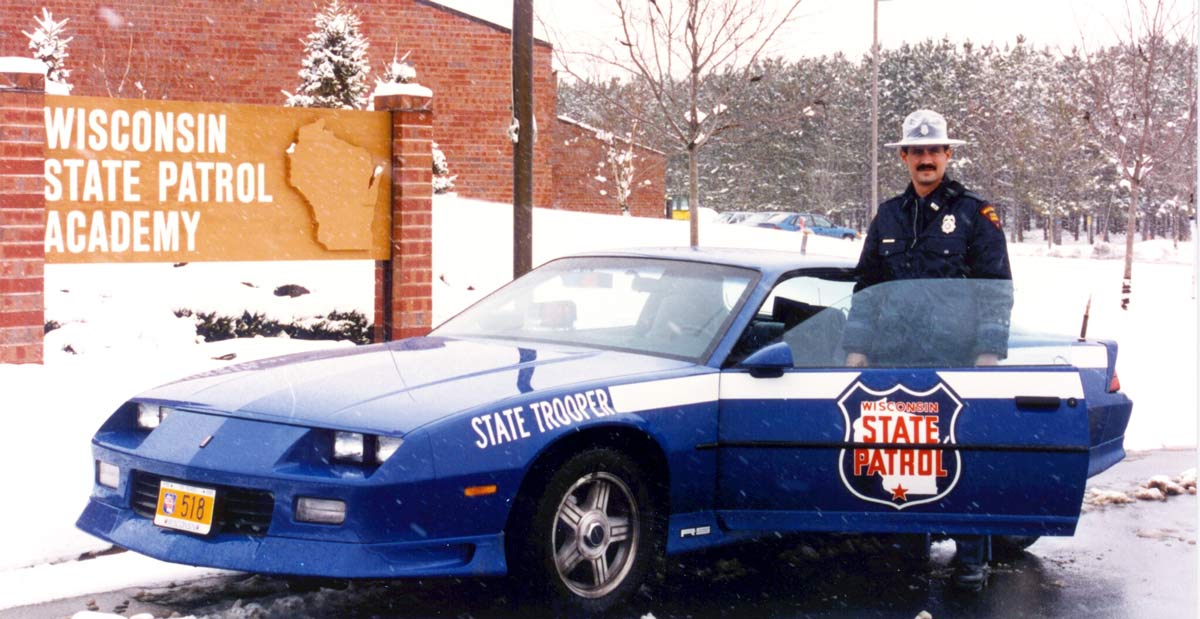 District 5 (Tomah)
District 5 (Tomah)
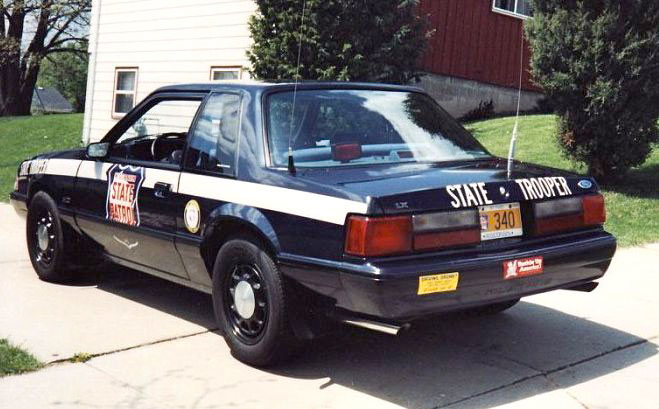
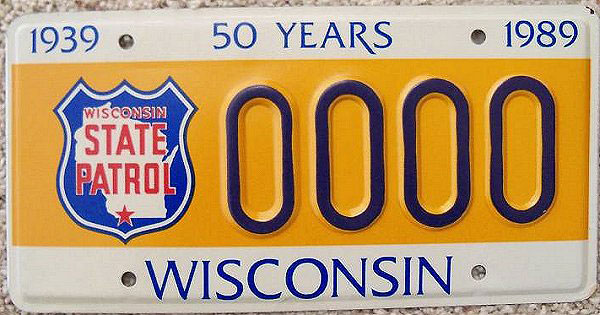 1989-2000 50th Anniversary Sample issue.
1989-2000 50th Anniversary Sample issue.
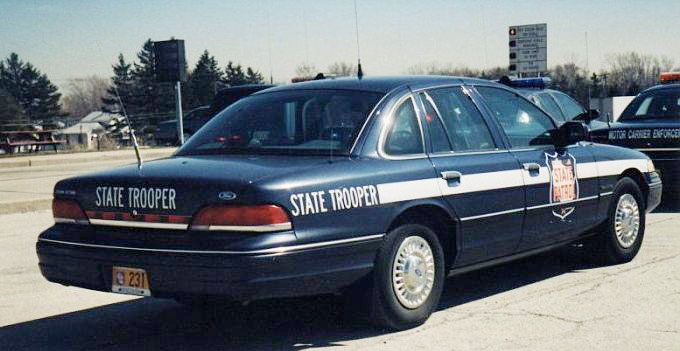
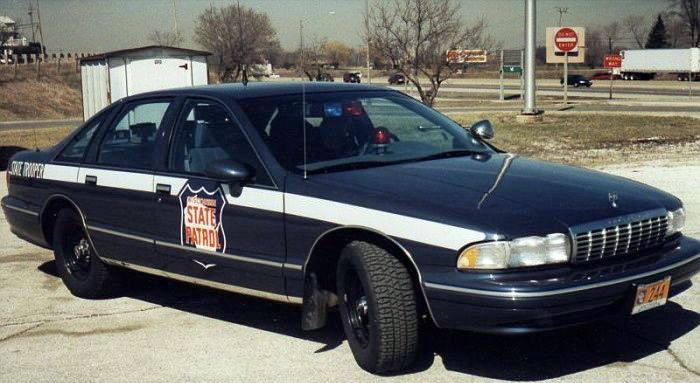
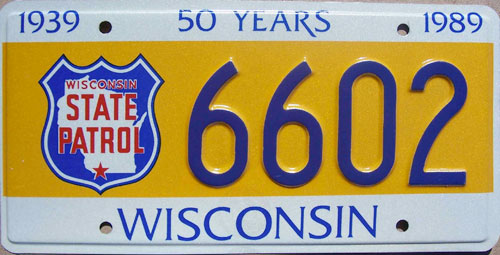 1989-2000 50th Anniversary issue.
1989-2000 50th Anniversary issue. 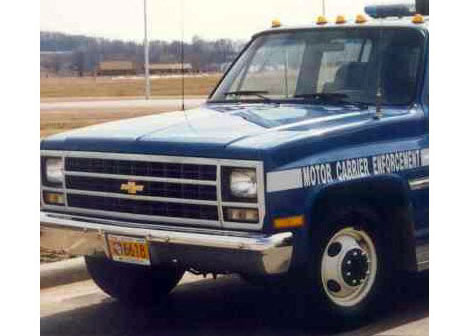 Eau Claire Motor Carrier Enforcement Unit 18
Eau Claire Motor Carrier Enforcement Unit 18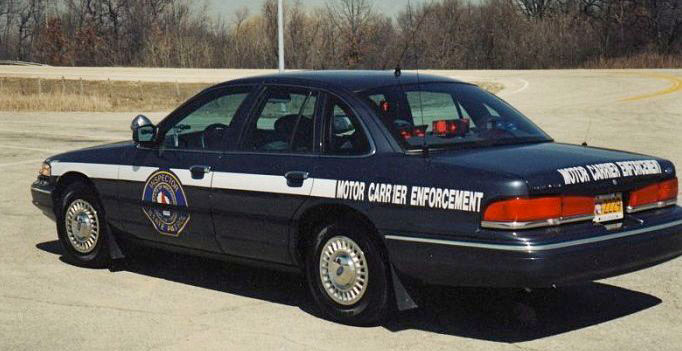
2000-Current issue. This embossed aluminum plate also has the image of the WSP door-shield emblem in full color in the center left field of the plate. This version has a reflective medium blue background at the top of the plate which gradually fades to white as it descends to the bottom. WISCONSIN is silkscreened in bold dark blue font in the top left corner of the plate while STATE PATROL is screened is smaller dark blue font in the top right corner of the plate. The slogan Improving Highway Safety is silkscreened in dark blue along the lower center span of the plate.
It was in 2005 when the WSP changed from Districts to Posts under Regional assignments:
1##: DeForest Post (Southwest Region)
2##: Waukesha Post (Southeast Region)
3##: Fond du Lac Post (Northeast Region)
4##: Wausau Post (North Central Region)
5##: Tomah Post (Southwest Region)
6##: Eau Claire Post (Northwest Region)
7##: Spooner Post (Northwest Region)
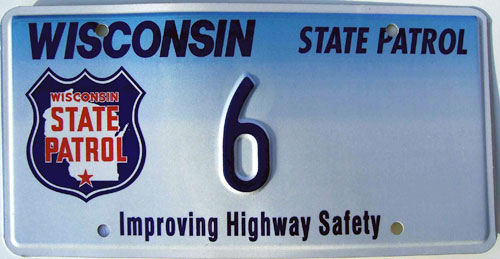 2000-late 2013 issue.
2000-late 2013 issue.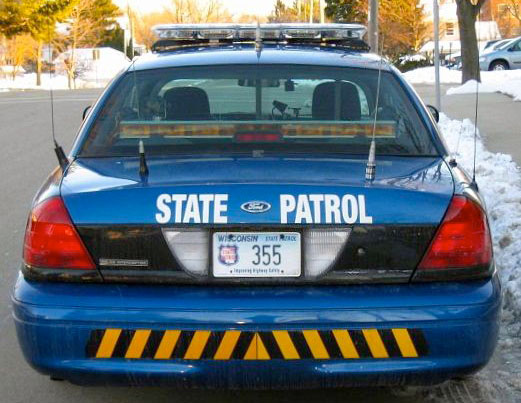
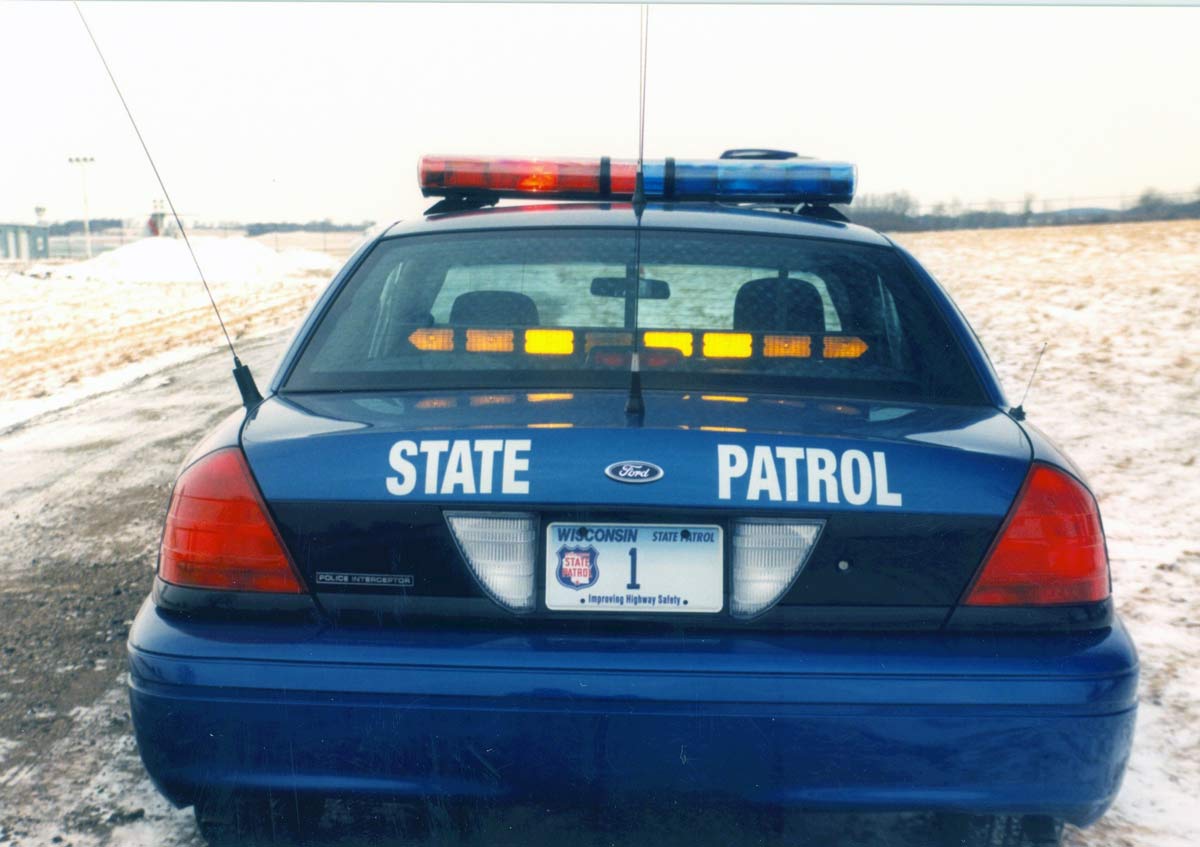 Car 1
Car 1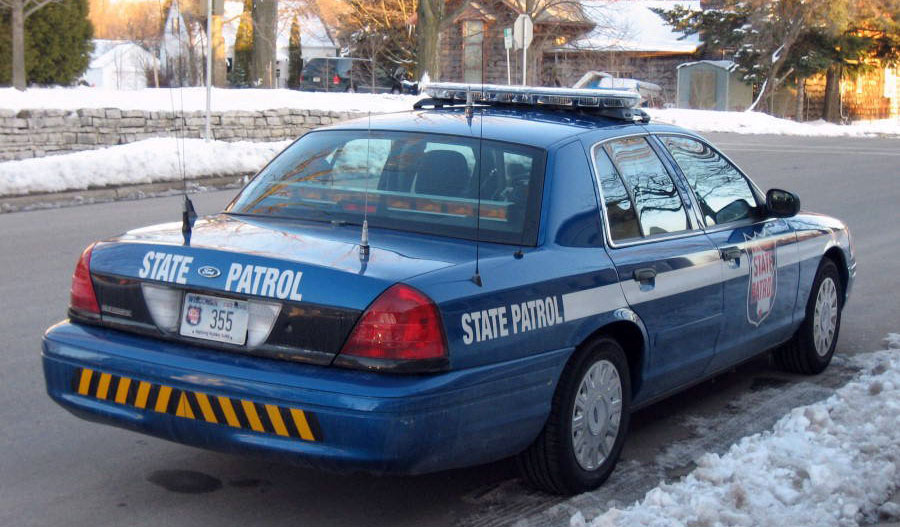
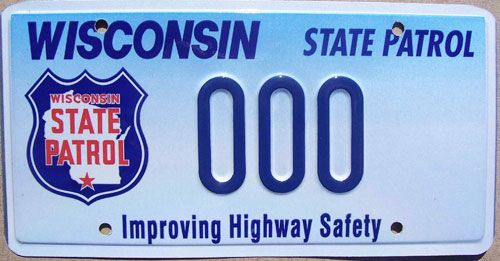 2000-late 2013 Sample issue.
2000-late 2013 Sample issue.
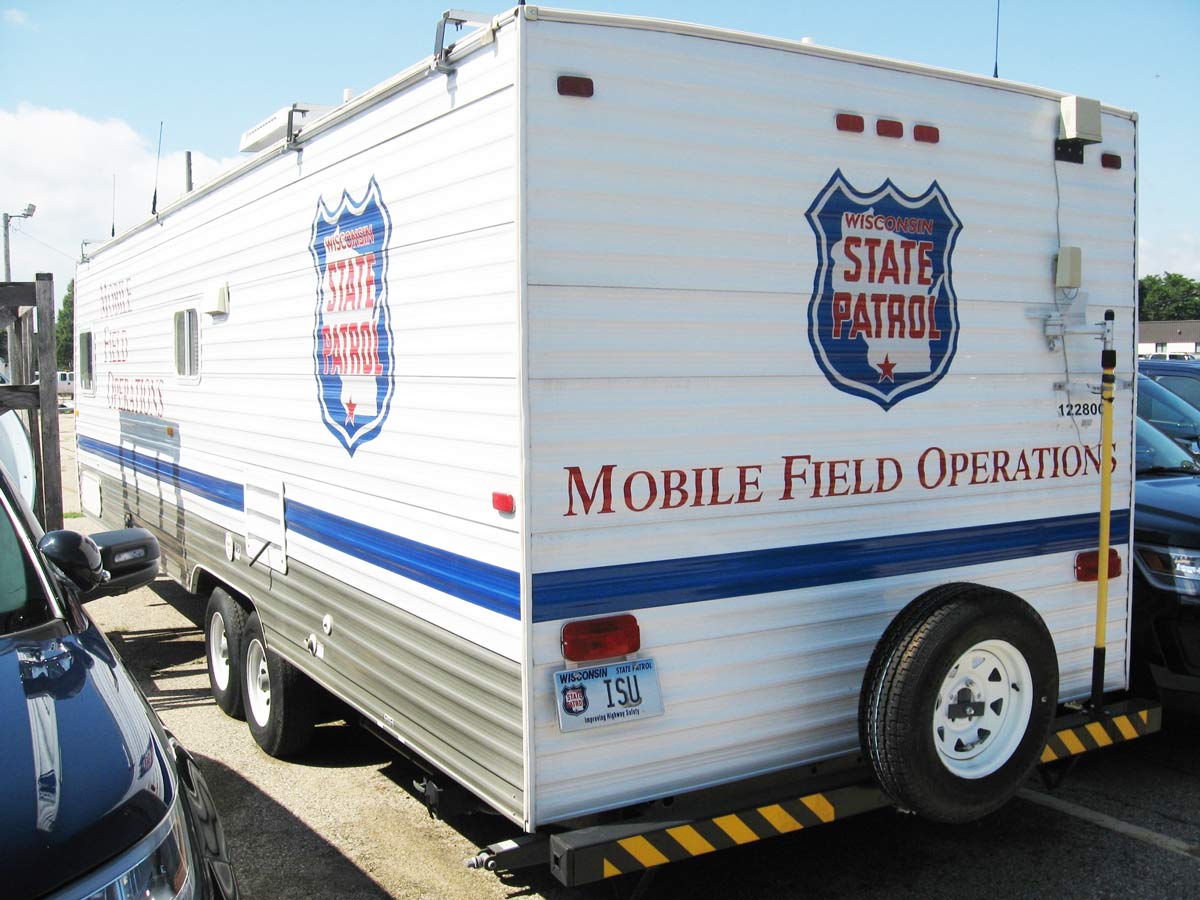 (Courtesy David A. Harvey- WSP/DOT Technical Services Section)
(Courtesy David A. Harvey- WSP/DOT Technical Services Section)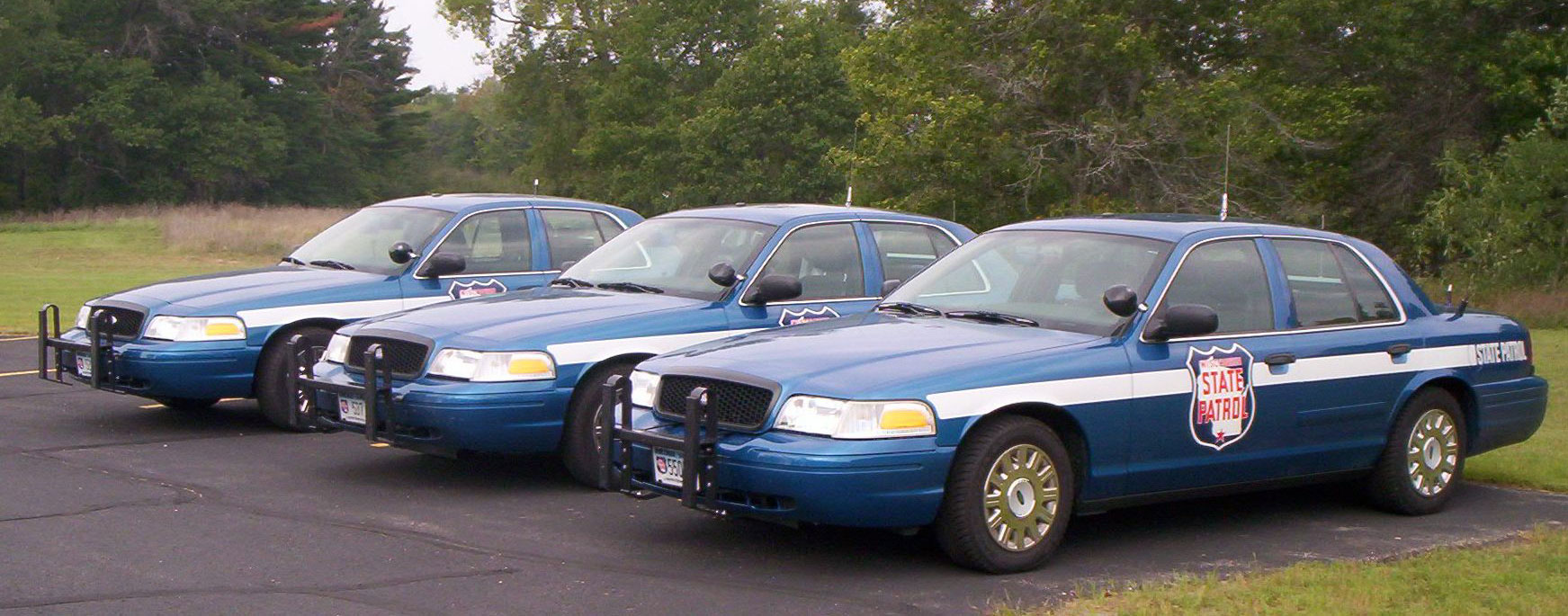
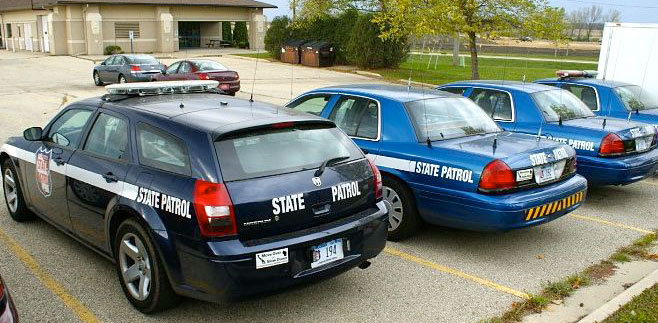
Much like they did in 1989 for their last milestone, the Wisconsin State Patrol commemorated their diamond anniversary with the commissioning of yet another bold graphic design license plate for their marked fleet. The embossed aluminum plate is colored dark blue over reflective white. A dark blue graphic band spans the top of the plate with 1939 75 YEARS 2014 in yellow, and another dark blue graphic band spans the bottom of the plate with STATE WISCONSIN PATROL. A stylized WSP shield occupies the center left field of the plate with a silver/grey halo at the neck of the shield. "Celebrating 75th Anniversary" is emblazoned on the halo. 1939 (red star) 2014 is placed at the bottom of the shield. The regular unit numbering is embossed in the center and right field of the plate.
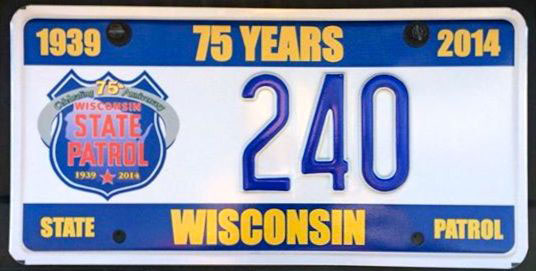 2014-Current 75th Anniversary issue.
2014-Current 75th Anniversary issue.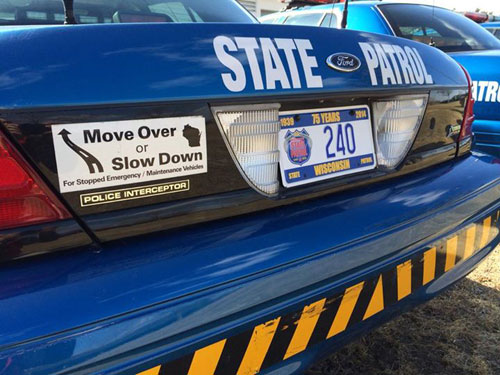

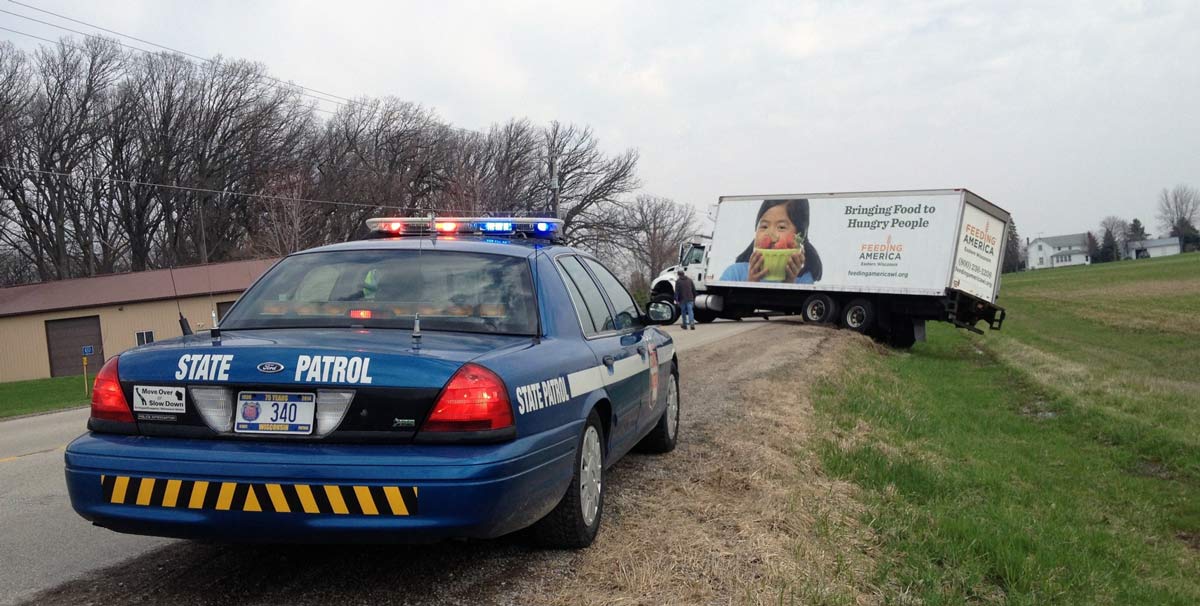 (Courtesy David A. Harvey- WSP/DOT Technical Services Section)
(Courtesy David A. Harvey- WSP/DOT Technical Services Section)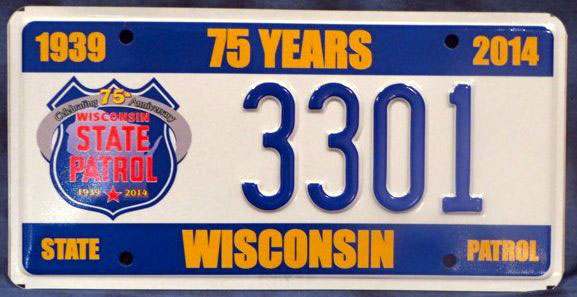 2014-Current 75th Anniversary issue.
2014-Current 75th Anniversary issue.
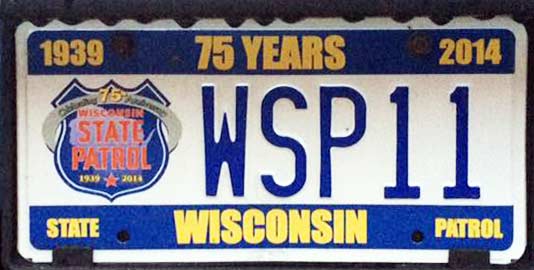 2014-Current 75th Anniversary issue.
2014-Current 75th Anniversary issue.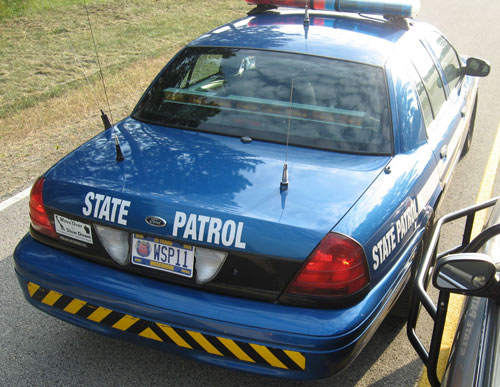
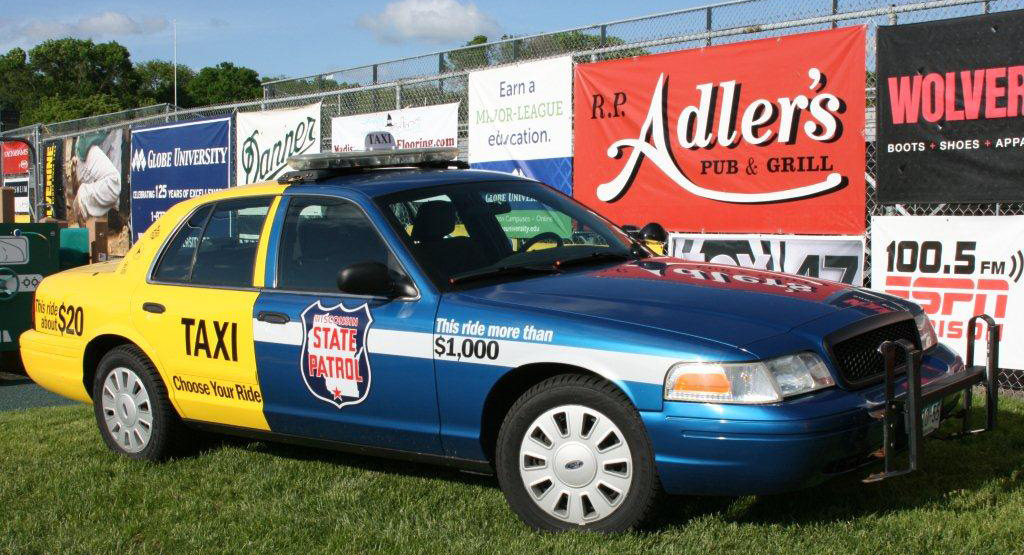 Wisconsin State Patrol/Taxi "Choose Your Ride" Message Car against drunk driving. These vehicles have used both the PICK 1 license number as well as the 10-55 (Radio Ten Code for Impaired Driver) number as seen below.
Wisconsin State Patrol/Taxi "Choose Your Ride" Message Car against drunk driving. These vehicles have used both the PICK 1 license number as well as the 10-55 (Radio Ten Code for Impaired Driver) number as seen below. 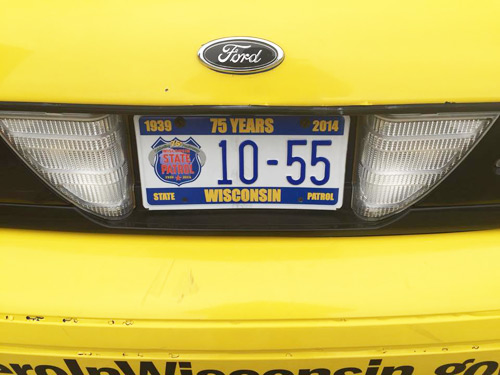
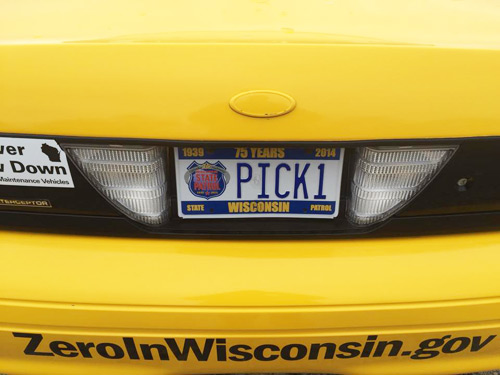
In July of 2019, the Wisconsin State Patrol replaced the 75th Anniversary license plates with a design that looked almost identical to the 2000-2013 issue. This version has the reflective medium blue background at the top of the plate which gradually fades to white as it descends to the bottom. WISCONSIN is silkscreened in bold dark blue font in the top left corner of the plate while STATE PATROL is screened is smaller dark blue font in the top right corner of the plate. The slogan Strive for Excellence is silkscreened in dark blue along the lower center span of the plate.
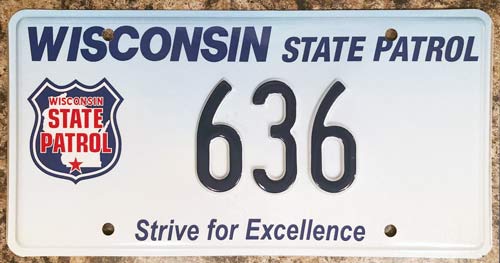 2019-Current issue.
2019-Current issue. 
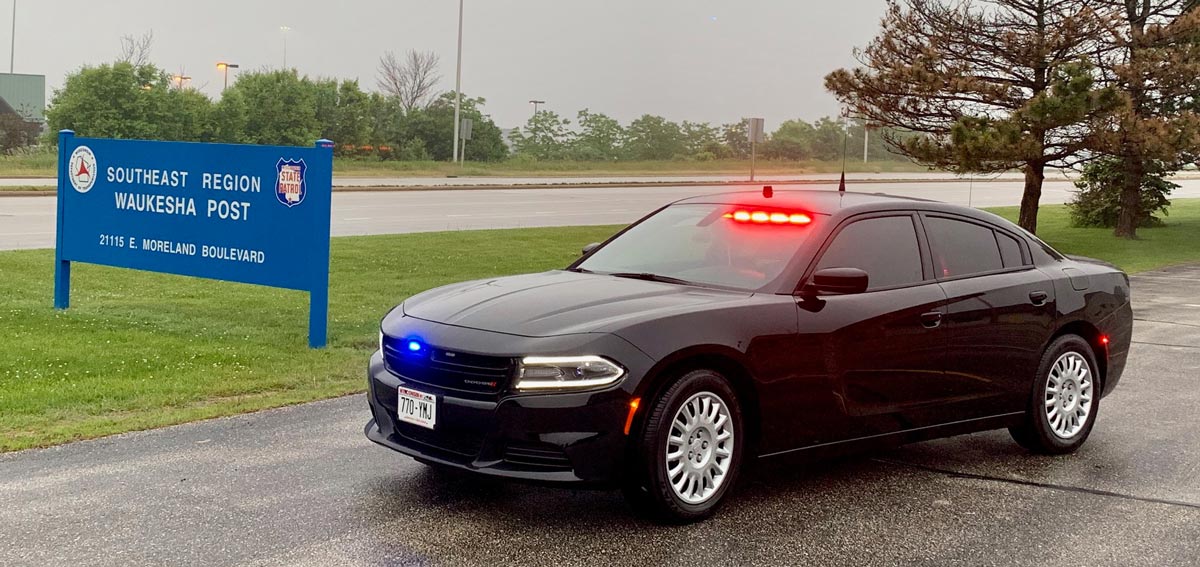 2019 WSP Unmarked with passenger license plate # 770-YMJ
2019 WSP Unmarked with passenger license plate # 770-YMJMotorcycle license plates used by the WSP are not as well-documented for their short use in the earlier days, but believed to be standard motorcycle issue plates. From the 1960's until 1989, the WSP used standard Wisconsin motorcycle plates but in the reserved number bloc of 4001 to 4100.
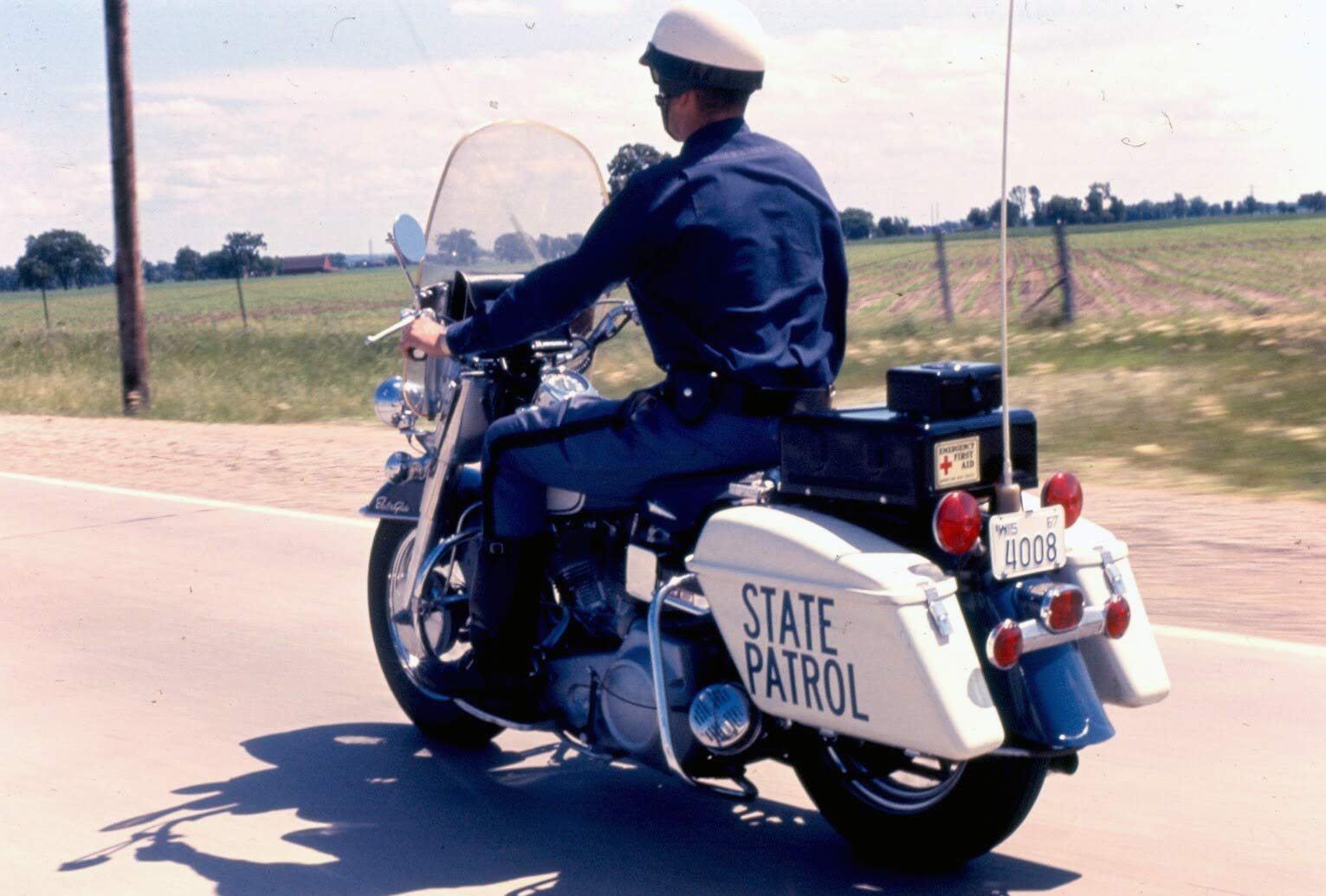 1967- 4000 series reserved for WSP use.
1967- 4000 series reserved for WSP use. 
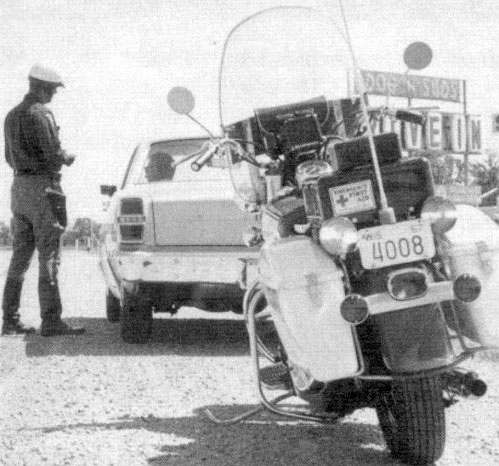 1967 WSP motorcycle in 4000 series.
1967 WSP motorcycle in 4000 series.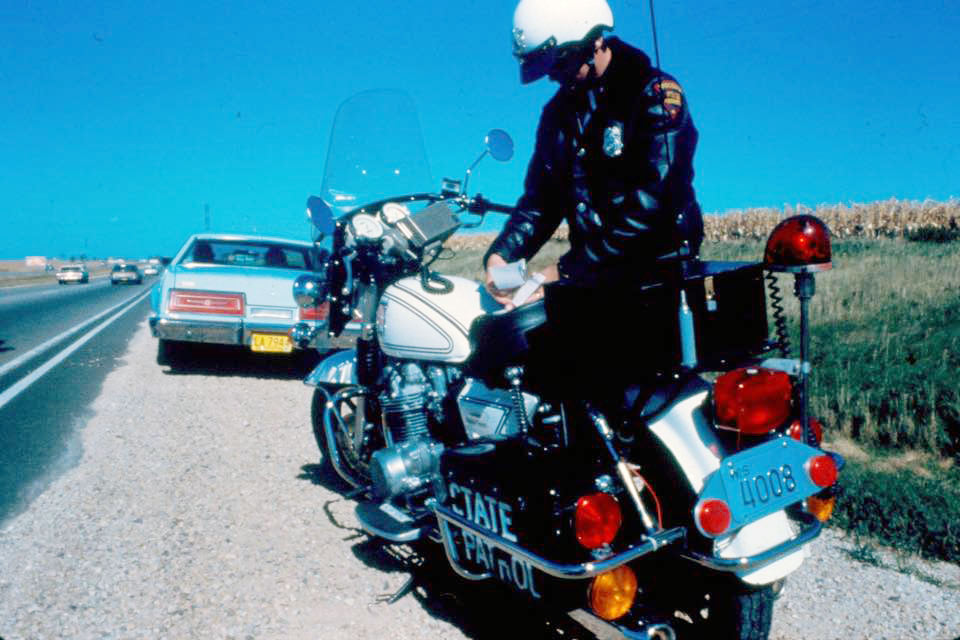
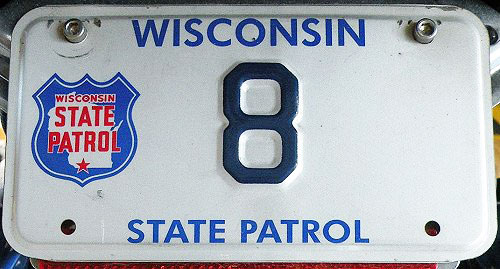 Circa 2000-2014 motorcycle issue.
Circa 2000-2014 motorcycle issue.
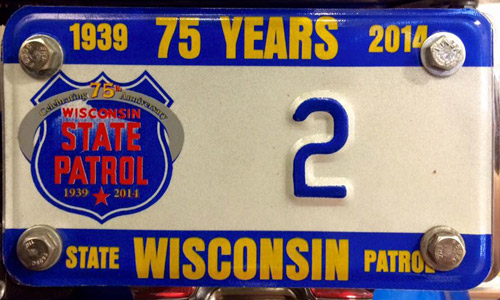 2014-2019 motorcycle issue.
2014-2019 motorcycle issue.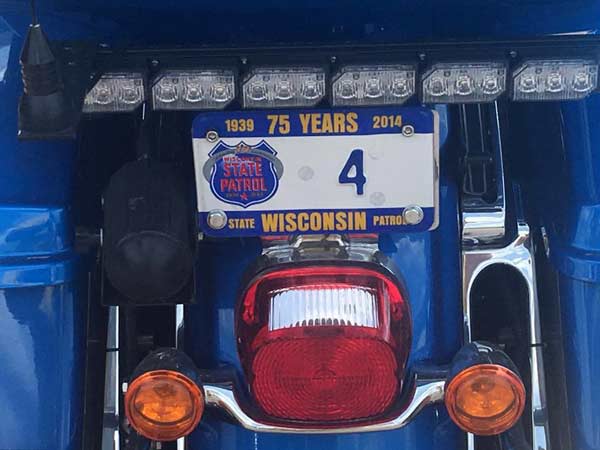
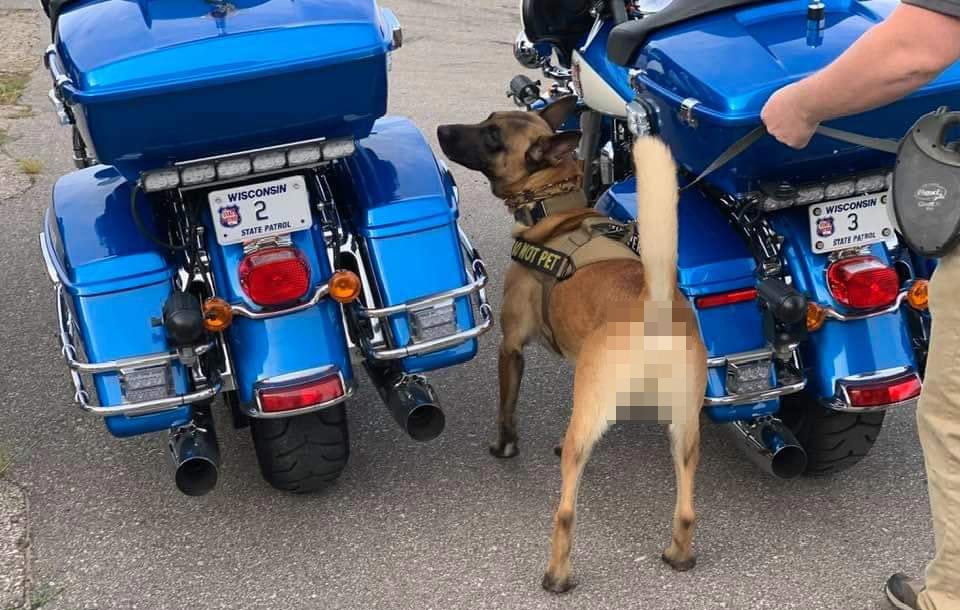 2020 WSP cycles...and censored K9's behind..
2020 WSP cycles...and censored K9's behind..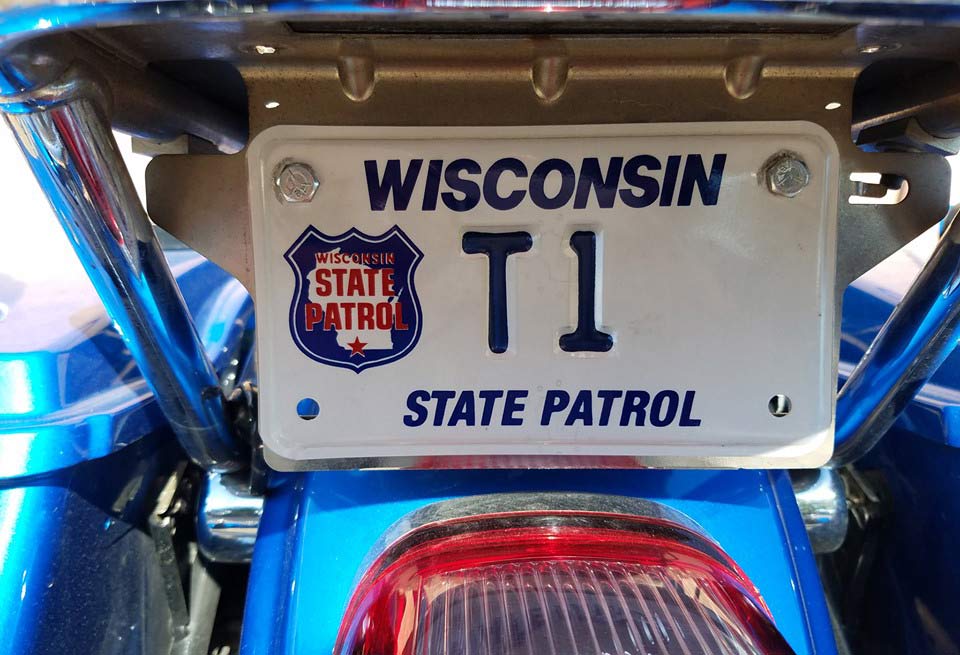 2019-Current motorcycle issue. Training Division.
2019-Current motorcycle issue. Training Division.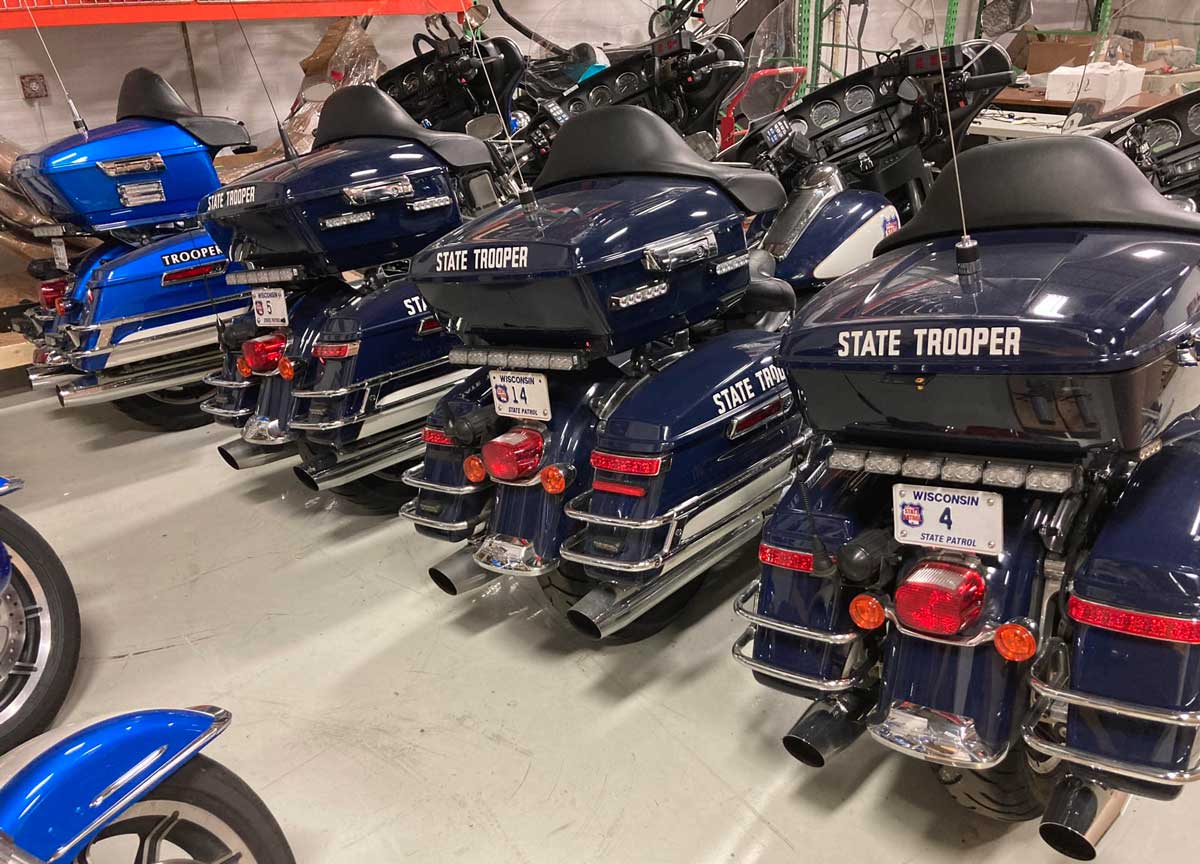 Sitting cycles
Sitting cyclesThe following are specialty issues attributed to the Wisconsin State Patrol.
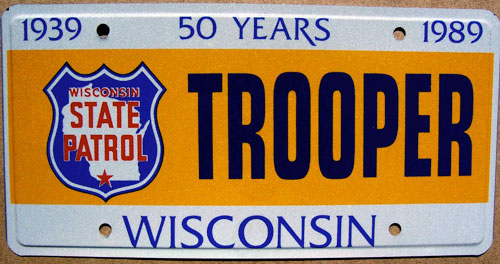 1989-2000 50th Anniversary issue.
1989-2000 50th Anniversary issue.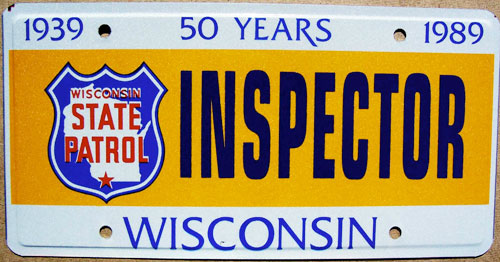 1989-2000 50th Anniversary issue.
1989-2000 50th Anniversary issue.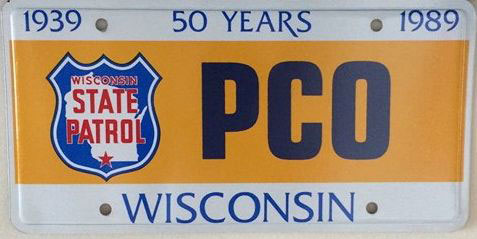 1989-2000 50th Anniversary issue.
1989-2000 50th Anniversary issue.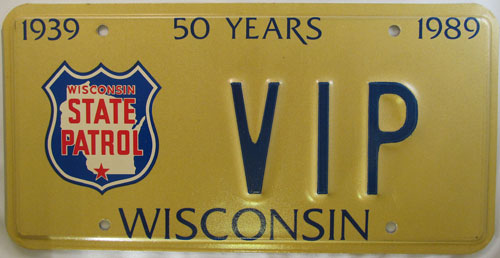 1989-2000 50th Anniversary issue for VIP.
1989-2000 50th Anniversary issue for VIP.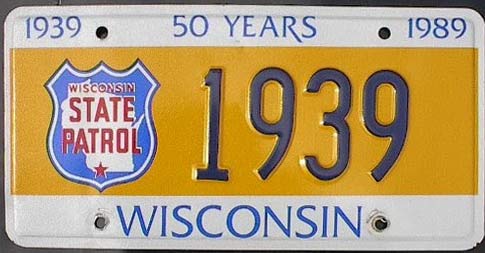 1989-2000 50th Anniversary issue for 1939 restored patrol car.
1989-2000 50th Anniversary issue for 1939 restored patrol car.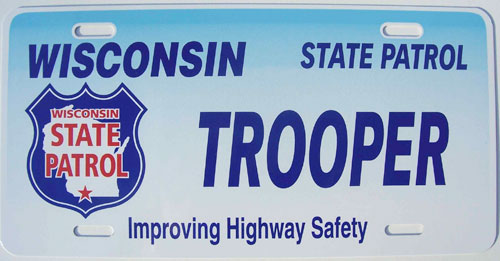 2000-2013 issue souvenir plate.
2000-2013 issue souvenir plate.